Birding paradise of Himalayan West Bengal
- With Nature Clicks
- April, 2021

Great Hornbills
Background
I had in mind this trip to the Neora, Mahananda Valleys in West Bengal for last 2 years but it did not materialize. Abhay asked again in the month of December and although the covid related issues were still lingering, I decided to go for it.
That was in Dec, but by the time we were to take the flight in April, things had worsened with the 2nd wave spreading like wildfire. 3 out of 7 had to cancel because of Covid. I discussed it with Sameer and finally we decided to go ahead. The special birds of the region were too big an attraction to avoid.
2nd April - Day 1
We had the morning flight at 8 going directly to Bagdogra. We reached as scheduled at around 11 and started our road journey to Lava.
As per government rules, we were ready with the Negative COVID report but no one even bothered to check it at the Airport (neither at Mumbai nor at Bagdogra). The only check at Mumbai was the temperature check before entering the Airport.
As we had left home very early, and did not want to eat anything in the flight (better keep the masks/face shields on all the time inside the plane), our first stop for brunch had to be quick. And the best place according to Abhay was Laddoo-Gopal in Siliguri. This seemed to be the favorite of all tourists (as almost half the flight was seen there – most of them were probably going to Darjeeling which was also a road journey from Bagdogra).
The restaurant wasn’t far from airport but there was just too much traffic on the road. It was better after that point as we started going towards the hills. It was a long journey so naturally I took my motion sickness medicine (and kept to the front seat of the vehicle). For most of the road, we could see a lot of greenery around and temperature got pleasant too (not so in Bagdogra, Siliguri)
We reached our destination “Passerine Retreat”, a home-stay in Rishyap by about 5pm. First thing I noticed was there were at least 3 different ways the place name was spelt (Rishyop, Rishap).
Our host Norbu, was also going to be our local guide. He was ready to greet us. It was a nice cozy place but pretty soon we realized the cold. With the winds blowing from the valley (we were staying on the edge of it), wearing thermals was the best option (I could not imagine such a thing, especially in April summer and that too coming from the humid-heat of Mumbai).
Little before reaching the destination, we had the sighting of the Mountain hawk eagle and the Verditer flycatcher (soon we realized there were just so many of them in this region).
First thing we noticed about this region was all houses had lots of flowers around them, they had small plastic bags with soil and colorful flowers (no pots). This seemed to be the culture of Gorkha land. The region we were in, is very much part of West Bengal but the default local language (and people) is Nepalee/Gorkhas. I guess this is part of the politically sensitive Gorkhaland.
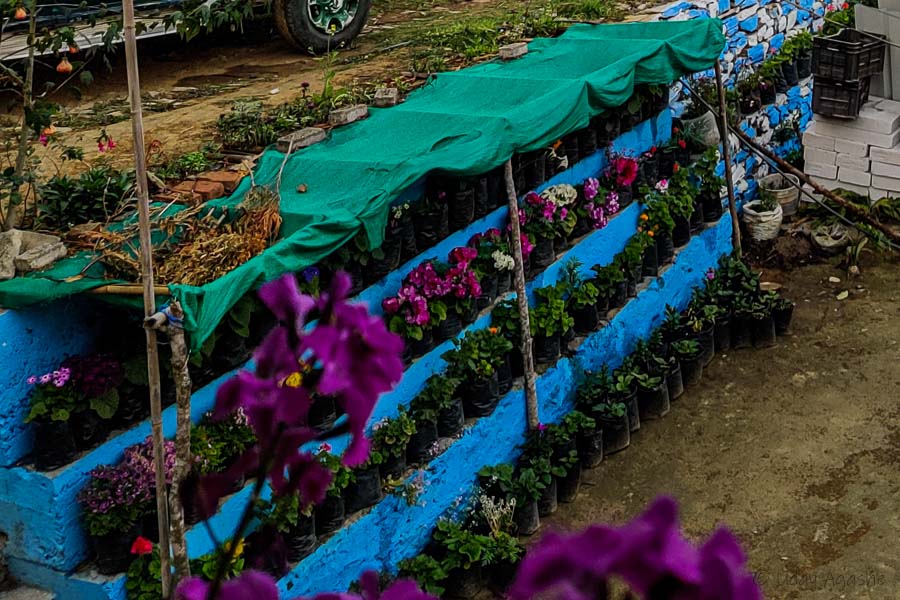
Flowers at our Homestay
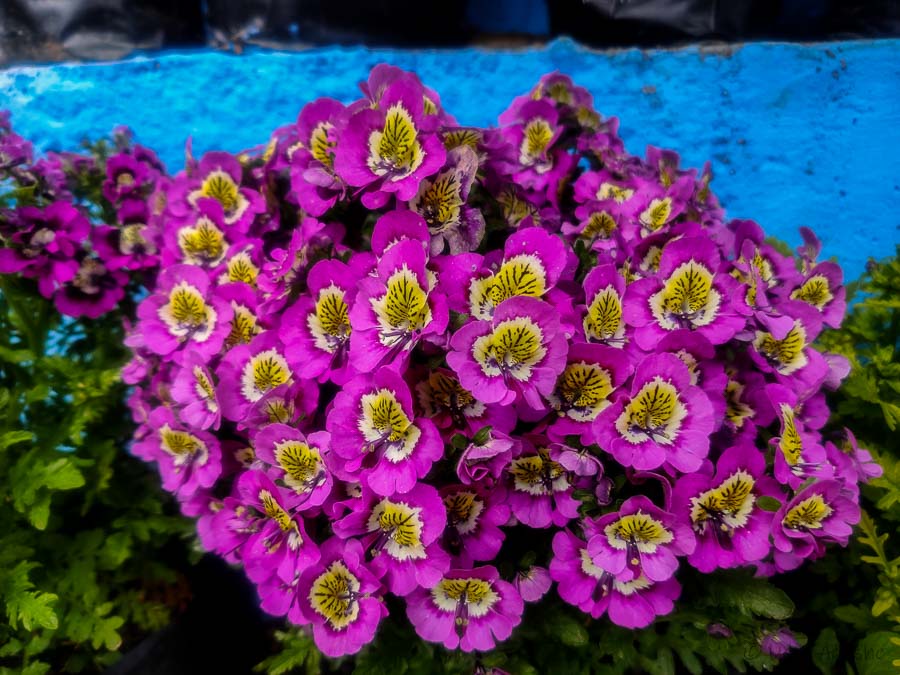
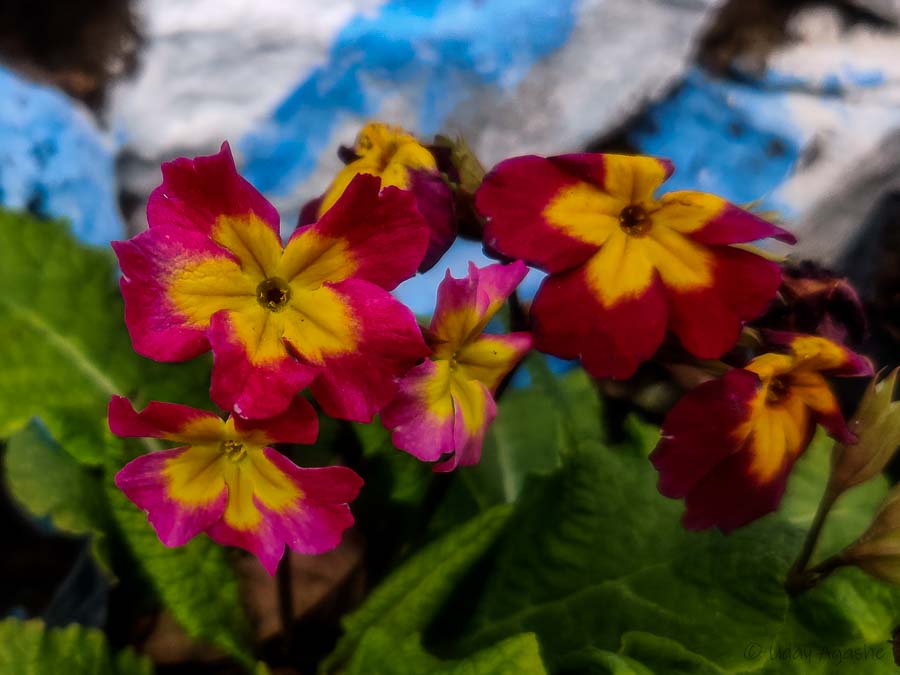
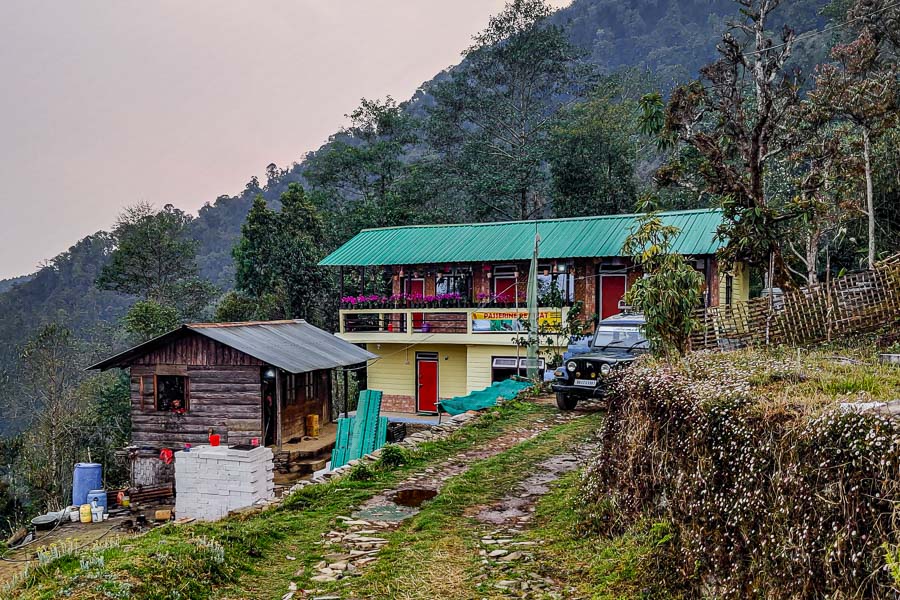
The Rooms
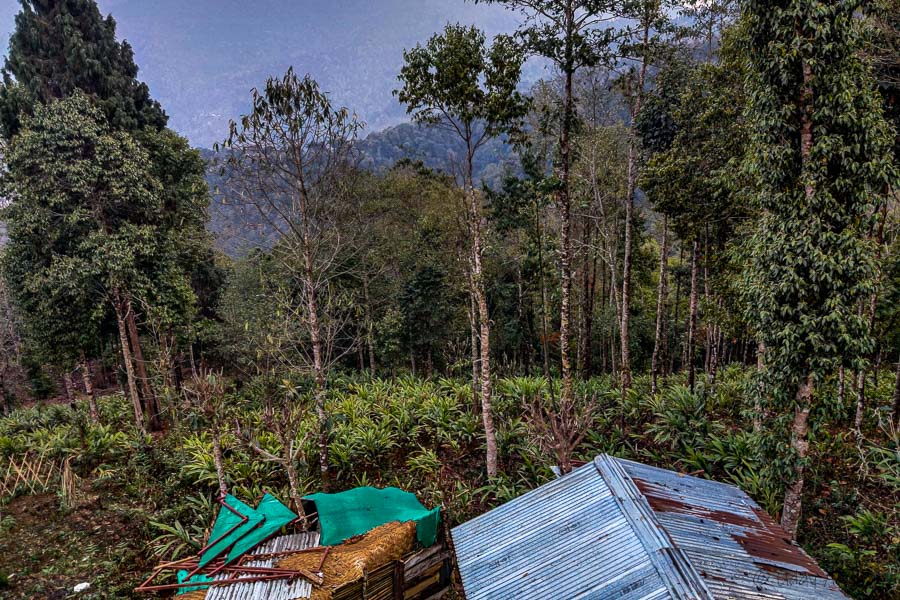
Valley Next to us
3rd April - Day 2
In this part, the Sun rises very early and accordingly we were all set for our first birding trail by 5:30 am. There was already decent light around.
Today’s plan was to do a walking trail of surrounding areas. Apparently, the whole area is normally full of flowers in this season but some recent heavy rains had spoiled the party for birds (and in-turn for us too). Abhay had told us about the finches here but they were missing. We anyway had to be content with the other birds (still quite a few – Verditer, Bushchats, blue-fronted redstarts, little bunting, and sparrows).

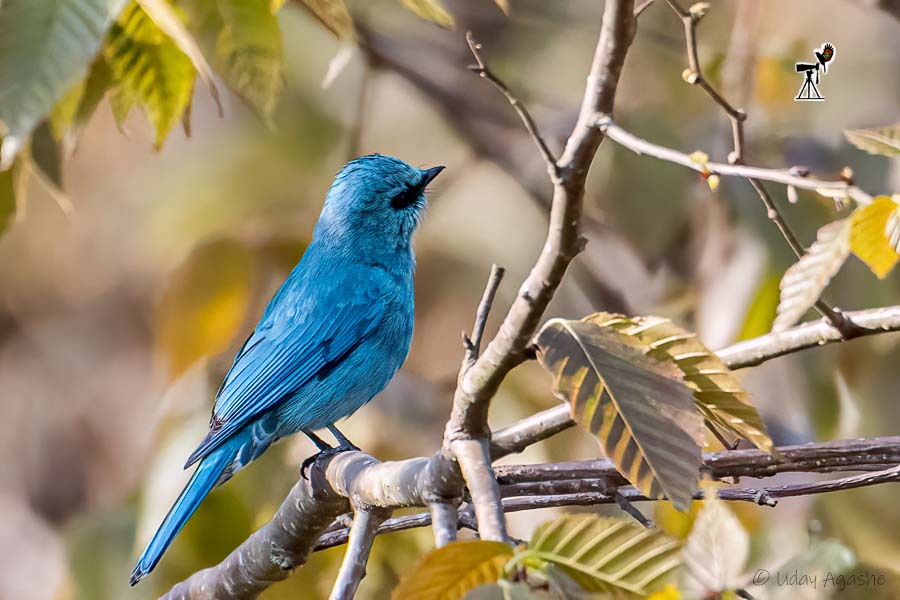
Verditer Flycatcher
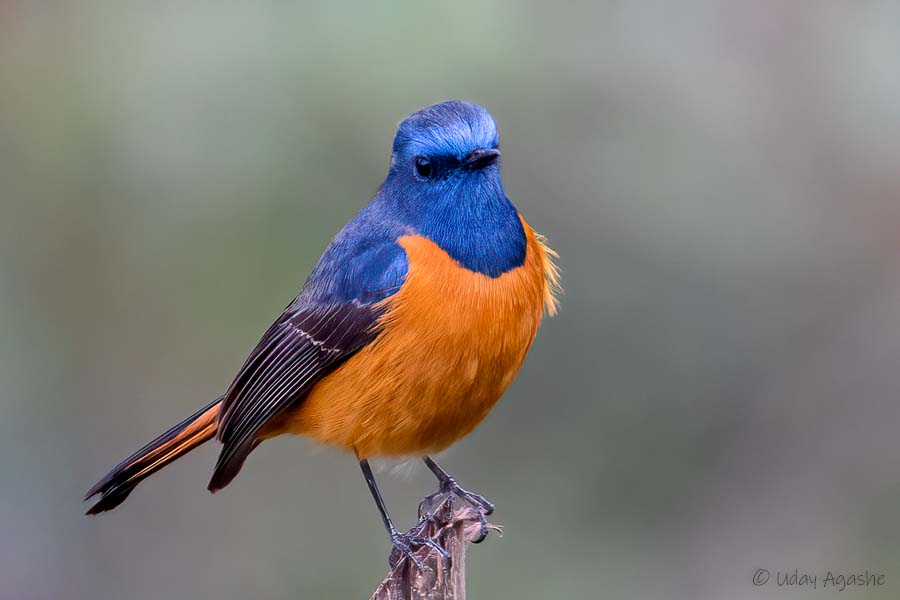
Blue-fronted Redstart
Walking trails are normally less taxing but here the trails were all hills (hardly any plain surface anywhere). And at 9000 feet from sea-level, even the small upslopes could be very tiring. Our enthusiasm was still strong anyway.
On the way we saw the yellow-nape woodpecker, grey-winged blackbirds, western crowned warbler, black-chinned babbler and lots of verditers.

Western-crowned warbler
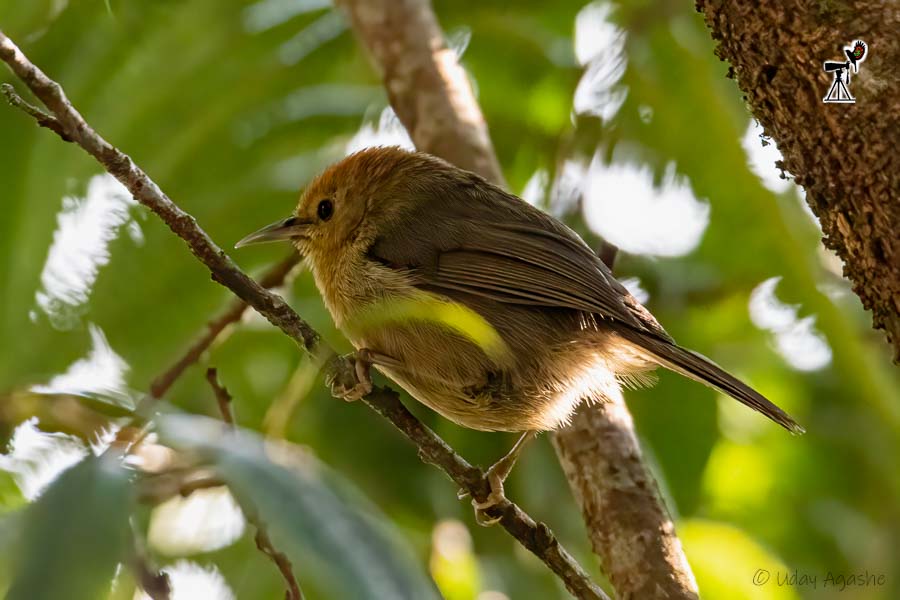
Rufous-capped Babbler
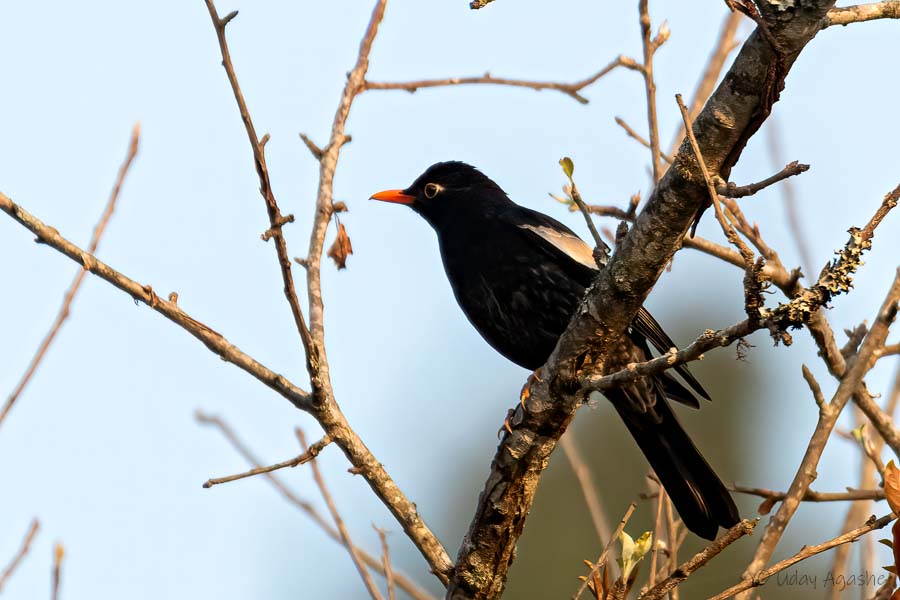
Grey-winged Blackbird
We kept hearing the known calls of the brain-fever bird (the common hawk-cuckoo) but we soon realized that although the calls are similar, this habitat is of Large hawk-cuckoo (has similar calls).
There were 2-3 target species that Abhay had in mind. Golden bush robin was one and then the Green-tailed sunbirds. He knew a location/trees where the chances of finding sunbirds (multiple numbers) were very high.
It was a really long trek … we waited patiently at the spot but there was only 1 pair of sunbirds and that too came after a long wait.
Little consolation was we could see a Himalayan cuckoo at some distance. Soon there was another male cuckoo and they seemed to have had a territorial fight.
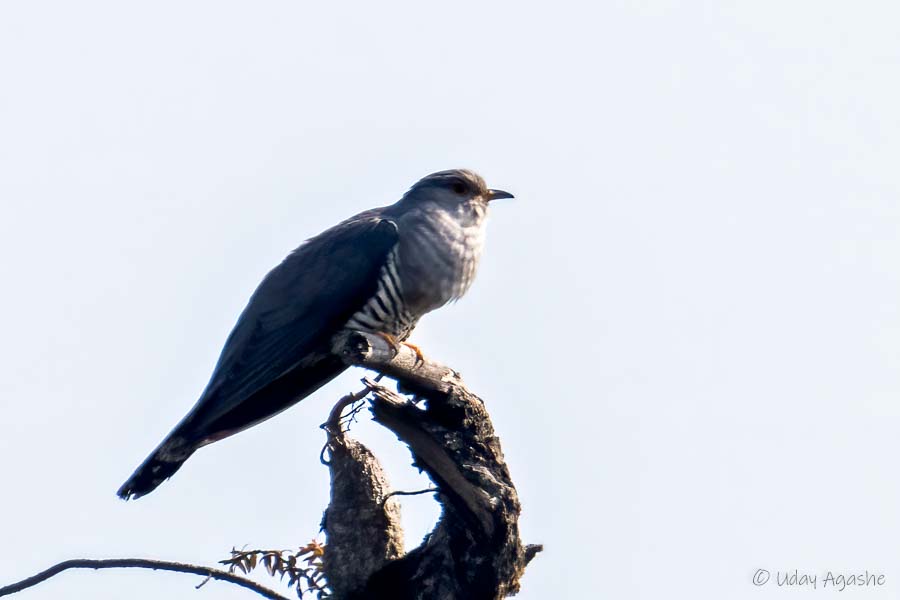
Himalayan Cuckoo
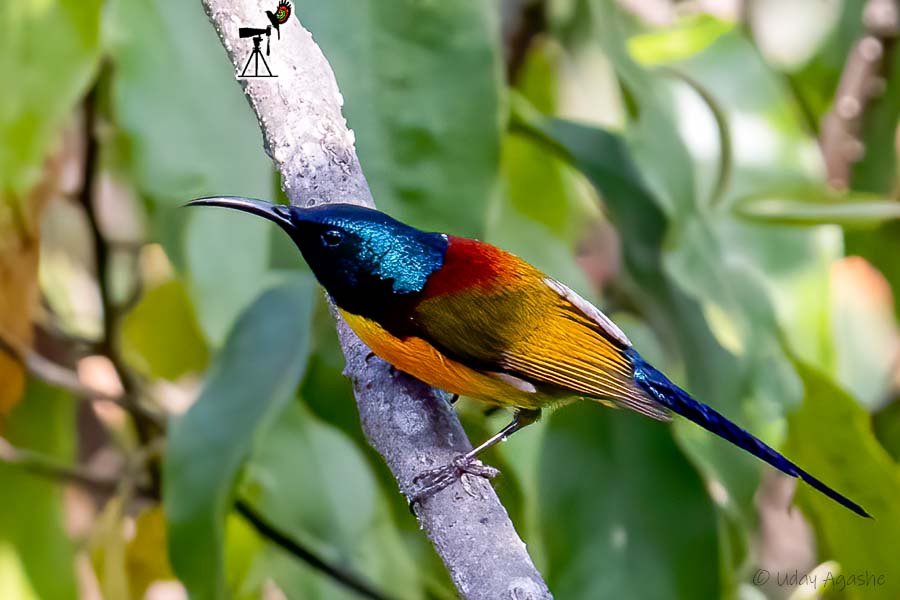
Green-tailed sunbird
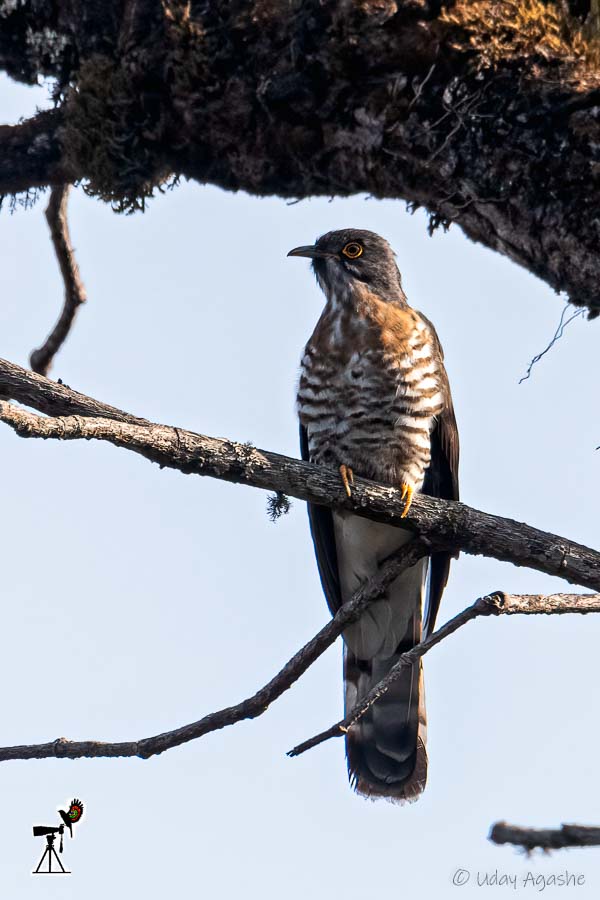
Large Hawk-cuckoo
On return, we took a different route. Here in one of the canopies, Prashant noted a reddish bird. It was hidden but with little efforts we all could see the Scarlet finch. Managed to get a few photos in that clutter (we waited but it just did not move out of that perch).
On the way, Abhay pointed us to another lifer, the Striated bulbul. He was able to locate it based on the calls. Little later Abhay asked us to look at another bird, we simply ignored it as we had seen so many of the verditer flycatchers. But he insisted! It was the pale-blue flycatcher. Similar shade of blue but much paler (we missed it assuming it to be a female verditer… normally female birds have duller shades).
As we were close to our homestay (it was already nearing 11am and we were very hungry), we could hear another set of persistent calls. Soon we were able to see the Grey-headed canary flycatcher.

Scarlet Finch
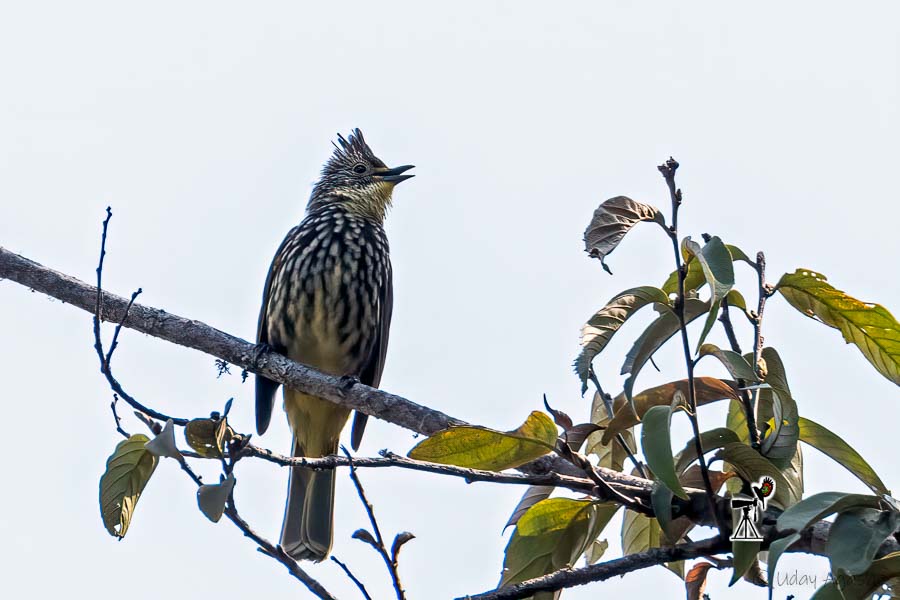
Striated Bulbul
At breakfast, we did not have very high expectation of the food but we were happily surprised (even the dinner yesterday night). Most of the meals had some preparation of potato (even the non-veg dishes it seems) but the taste was good.
After breakfast, we decided to first scan the area around our homestay.. a picturesque location it was. Another set of buntings, redstarts and bush-chats later, we even saw the Niltavas (both large & rufous-bellied ones).
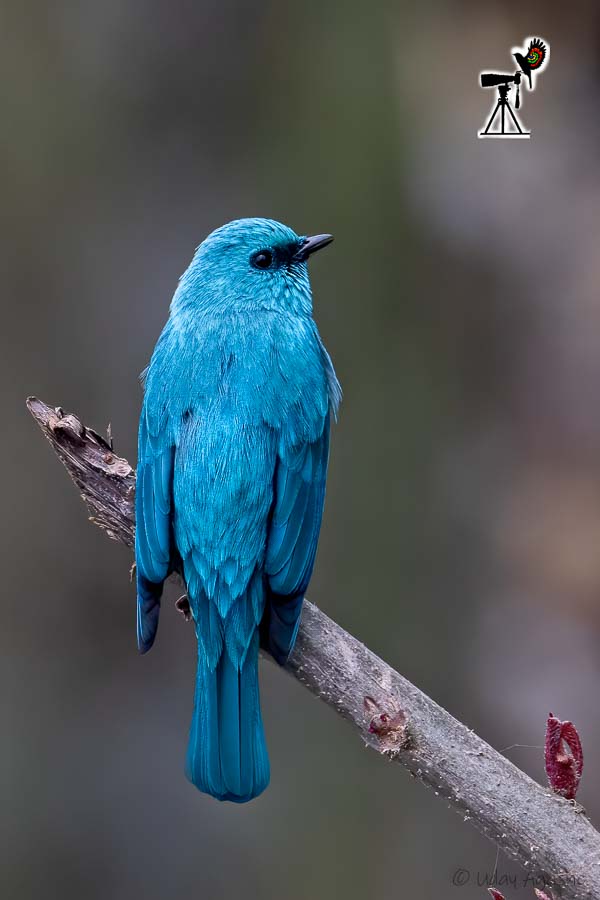
Verditer Flycatcher
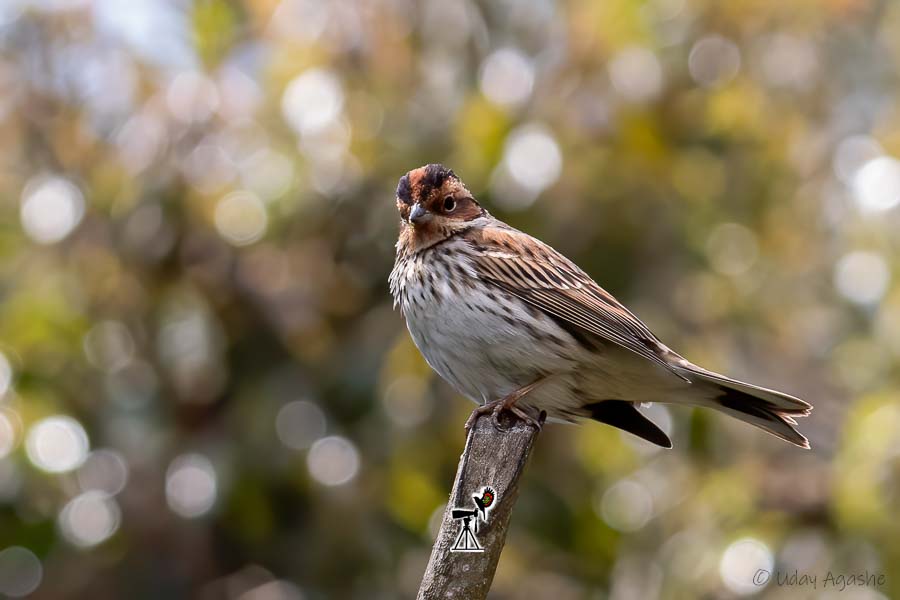
Little Bunting
Around noon, we again went out in search of more forest birds. Once again spent first 10 odd minutes with the Grey-headed canary flycatcher. Then we went in search of some other target birds but with no luck. Little further, we could see some movement around the tree trunk. Such movement is typical of the treecreepers or the nuthatches (they keep moving along the trunks instead of branches).
On close observation (and some guidance from Abhay) we could see the nuthatches and they were 2 different species entirely new to me (Indian nuthatch and white-tailed nuthatch).
After that we got to see the fire-breasted flowerpeckers. They were enjoying the flowers/fruiting from their favorite trees. At one point, I was able to get a nice shot of the flower-petal having same color as the fire-breast.

Grey-headed Canary Flycatcher
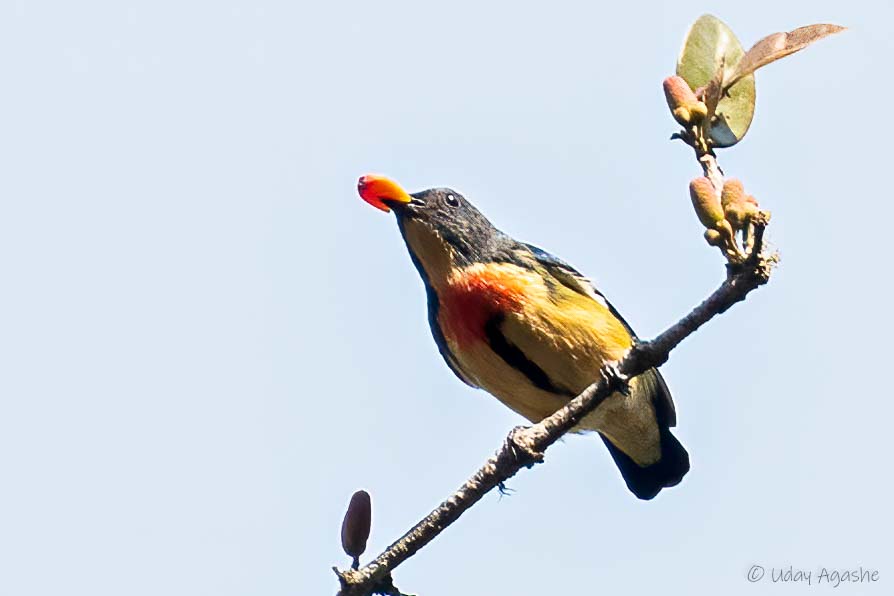
Fire-breasted Flowerpecker
It was just about 3:30pm but we were tired and there were not many birds seen, so we decided to close the day there.
In the evening we had long discussion over Himalayan birds and photography over the snacks. Dinner was at 8 and lights-out by 9:30. That kind of became the routine for this trip.
4th April - Day 3
Today our plan was to travel to a little far-off place, the Kolakham area & the Changay falls. Today’s primary targets were Mrs Gould's sunbird and Golden-throated Barbet.
We decided to do birding along the road from the vehicle and get-down when required. And immediately within 5 minutes, we had to get down (and this kept on happening every 5-10 minutes on that internal road. This road width was just enough for a vehicle to pass and that too a kachcha road. But the bumpy slow ride was good as we had sufficient time to look for bird activity on both sides of the road.
We started with the common birds, the blue-capped rock thrush, niltavas and few others. At times we were able to catch the activity of the laughingthrushes but they were foraging on the ground and were hardly visible in the undergrowth.
As we were listening to their movements, one smaller bird occupied a branch nearby. It looked different so we snapped a few photos quickly. It turned out to be Himalayan Bluetail (female).
Little further, we were greeted by the activity of another lifer, the Himalayan Cutia. There was a small group but they were moving thru the leaves so fast, hardly allowing us any opportunity to focus on them. Got a few record shots and got back into the vehicle.
Once again within 5 minutes, we had to stop for another bird activity. The fruiting trees nearby were full of bird calls/activity. Within next 10 minutes, we were able to site the Green-tailed and Fire-tailed Sunbirds, the Rufous Sibia and the whiskered Yuhinas. We now decided to just keep walking on the road (and asked the driver to just follow us – keeping some distance from us so as not to disturb the birds near us).

Whiskered Yuhina
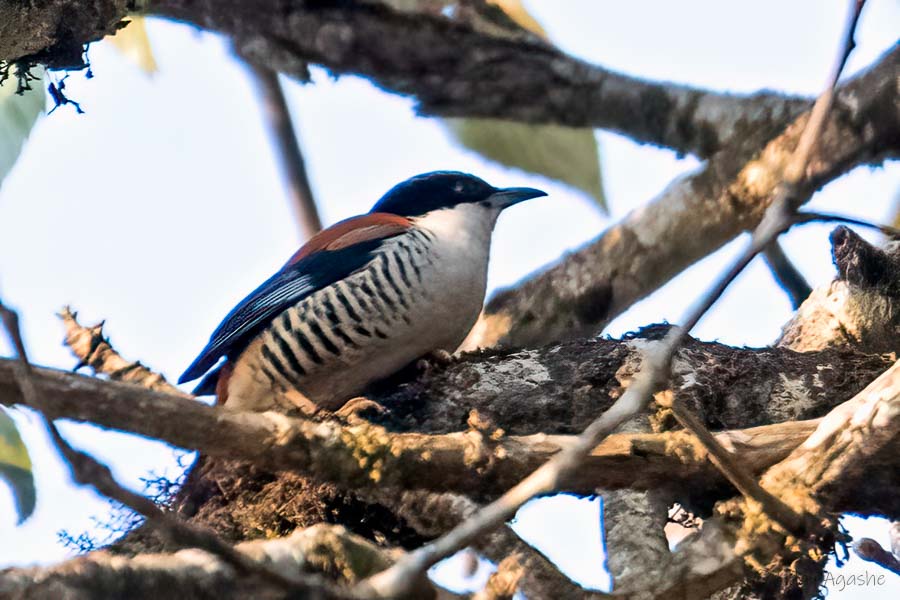
Himalayan Cutia
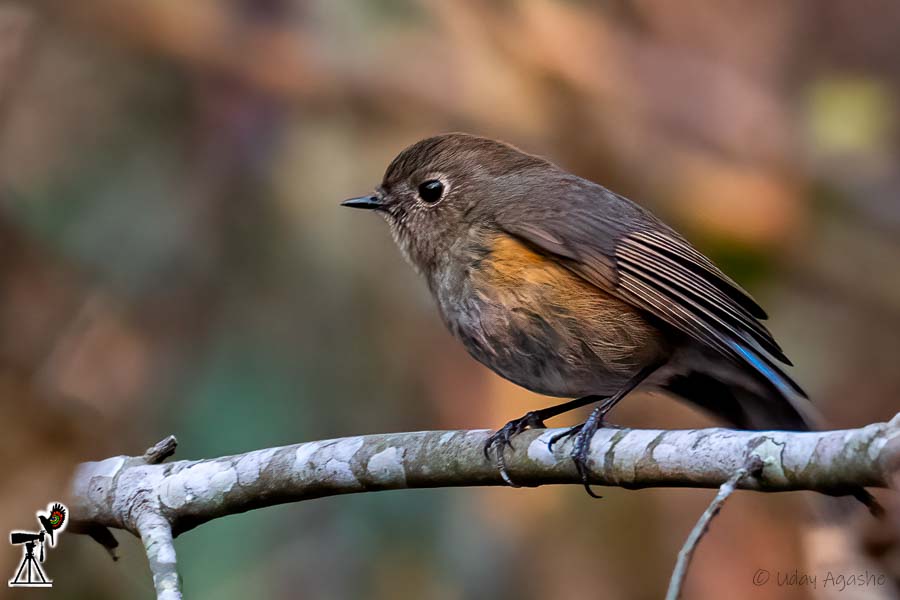
Himalayan Bluetail
Here we saw a bid with a long tail flying across, we followed its flight and allowed it to perch on a far off tree, turned out to be the yellow-billed blue magpie (very similar to the red-billed that I had seen earlier in Sattal). It did not stay for long but allowed me a quick photo. While I was busy with that, Abhay had picked-up another bird activity in the canopies. Another set of birds seemed to be moving from branches to branches (but the dense vegetation meant we could hardly take any photos). We really struggled to see the birds clearly (identified as the Hoary-throated Barwing) let alone taking snaps.
On the other side of the road, there were another set of birds and they also looked uncommon. They were relatively easy to photograph as they were moving on the tree trunk. These were the Rufous-winged fulvettas.

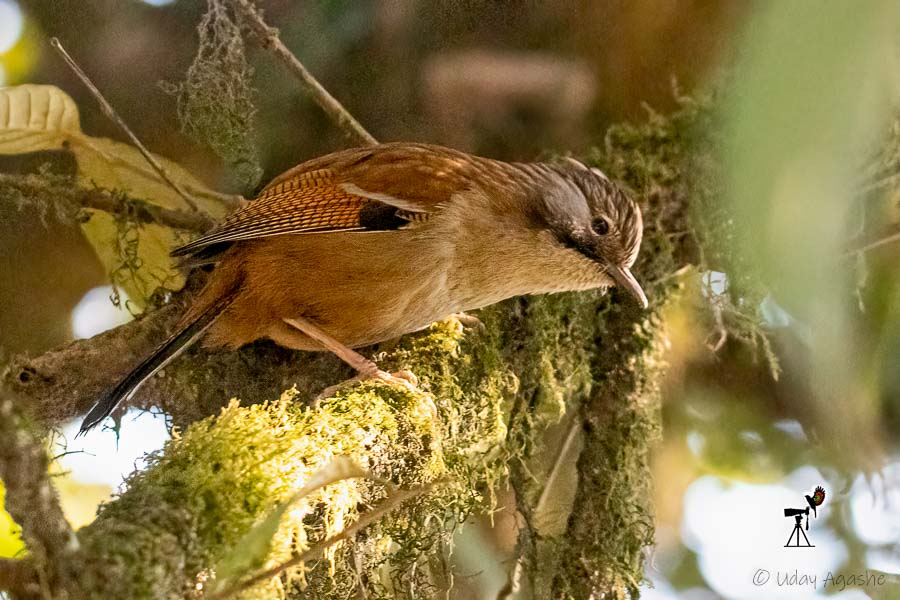
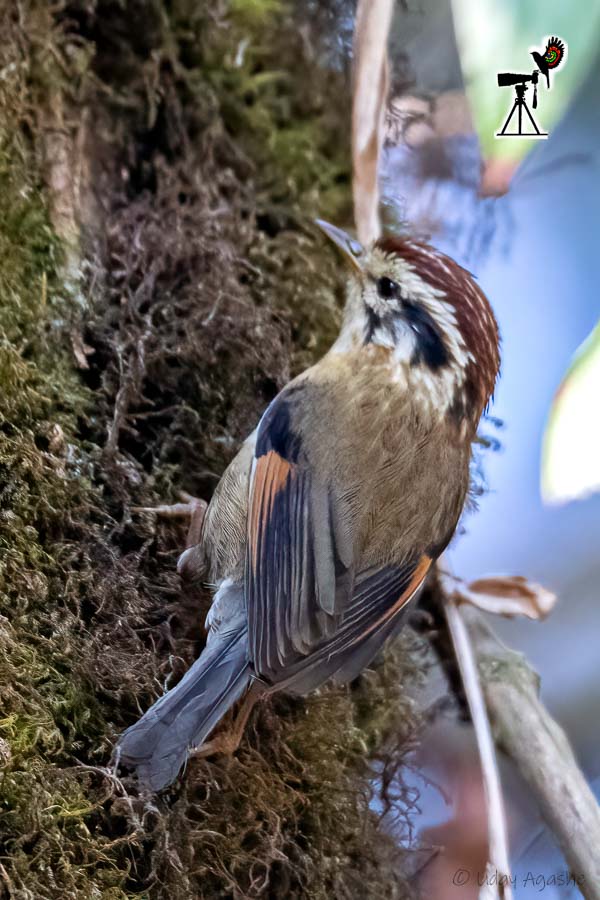
We were observing all this bird activity on that kachcha road. It was already 8:15 by the time we reached the main highway (was hardly 2-3 kms distance). We were now in the Lava town and since we had got up at 4:30 in the morning, the hunger struck big-time!!
We decided to have breakfast at one of the local places. Managed to get omelet-bread and the local maggi equivalent noodles (the Wai wai) followed by tea.
With full-stomachs now we were back on the birding trail. We crossed the Lava town and entered the Kolakham jungles. Little inside Abhay asked the driver to stop. He was very sure that we can see the Mrs. Gould’s sunbird in this region. We waited patiently and the bird did come little later. But before we could take any meaningful photos, it was driven away by a loud-noised vehicle that was passing on the road.
From there, we decided to walk ahead. Waited again after about 200 meters where there were signs of bird activity (calls and movements behind leaves). Here we got lucky with the sunbird.
We could also see some minivet species nearby. This action was on the trees that were near the road. Little below, in the valley we could see the movements of the white-throated fantail.
Further down we could see some warbler activity as well and there were some more minivets. As we were busy clicking the minivets, the cute little black-throated bushtits suddenly appeared from nowhere. A brief presence and they moved inside the valley, followed by another brief stay, this time by the fire-breasted flowerpecker.
The sunbird was still nearby and he made another entry on the scene. Once again, all our cameras were busy with the colorful subject.

Minivet-male
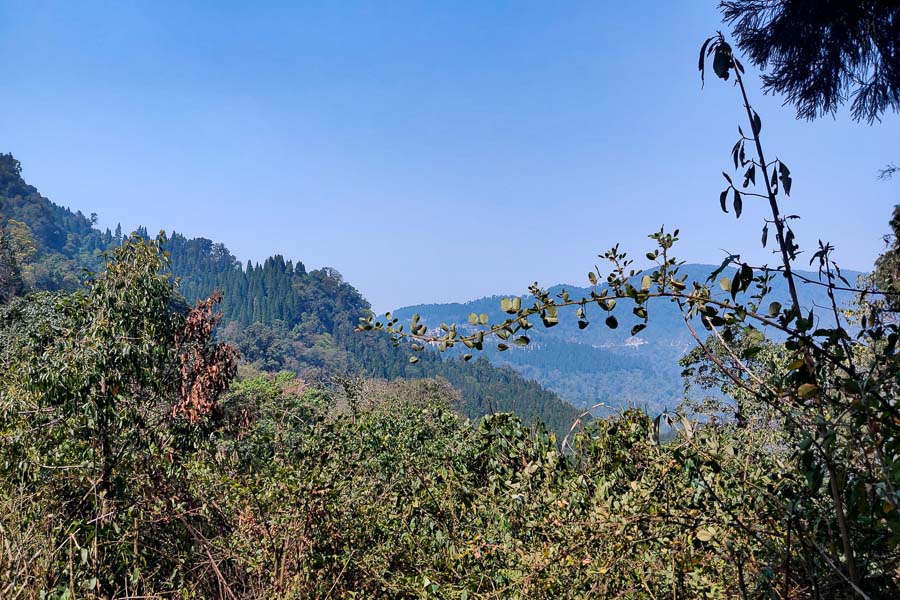
Kolakham Valley
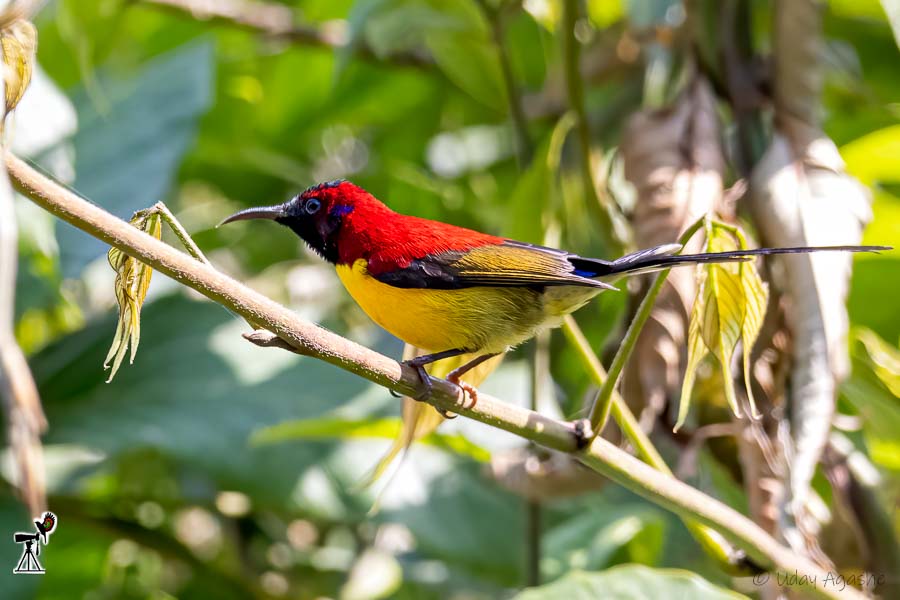
Mrs. Gould's sunbird
Time was moving fast, by the time we reached near the Kolkham valley, it was 11:30. We had a quick trail of the river stream. It is typical habitat for the water redstarts but we couldn’t find any (better chances of seeing them early mornings and evenings I guess).

River Bridge
We were back on the road, went little further till a small restaurant joint at the corner. That seemed to be a parking point for tourist vehicles. Our driver decided to go further ahead (simply to find a place where we can turn back the vehicle) and that turned out to be a lucky break.
Here we spotted some activity in the nearby trees. We got down to check and it was the Little-pied flycatcher that was nicely perched in the tall tree.
We just wished to see the barbet when Prashant mentioned about some bird in the same tree. Our guide looked at it reluctantly but soon realized that it was indeed the Golden-throated barbet. Suddenly all cameras were pointed in that direction. The barbet kept on calling and continued on the perch for more than 10 minutes.
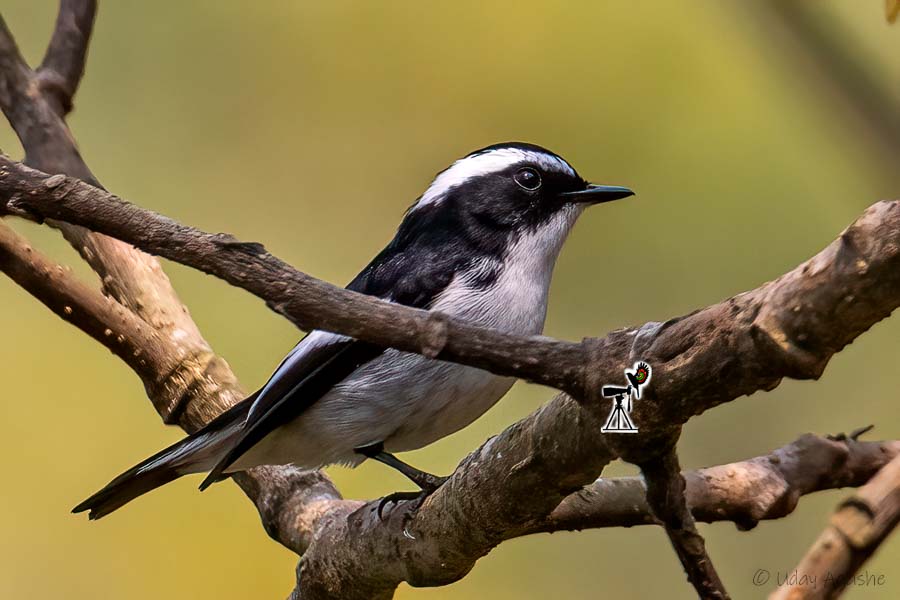
Little Pied Flycatcher

Golden-throated Barbet
As the barbet decided to fly, on the same tree we saw the black-throated sunbird. It was there for only a brief moment, we could only photograph a black outline of the bird.
Next on the adjoining tree came the Orange-bellied leafbird. Although the female gave us a few good photos, the male flew away too fast.
Within next 5 minutes Abhay was shouting again asking us to come back to the same tree, this time there was a group of 3 Sultan Tits that had perched atop. Naturally, another set of click-clicks followed
Within the span of half hour, we saw 4 lifers and that too when we were least expecting it. But no one was complaining 😀!!
During that time, there were fire-breasted flowepeckers, minivets and a black-bulbul who also marked their attendance, but in the flurry of lifers we couldn’t pay them any attention.
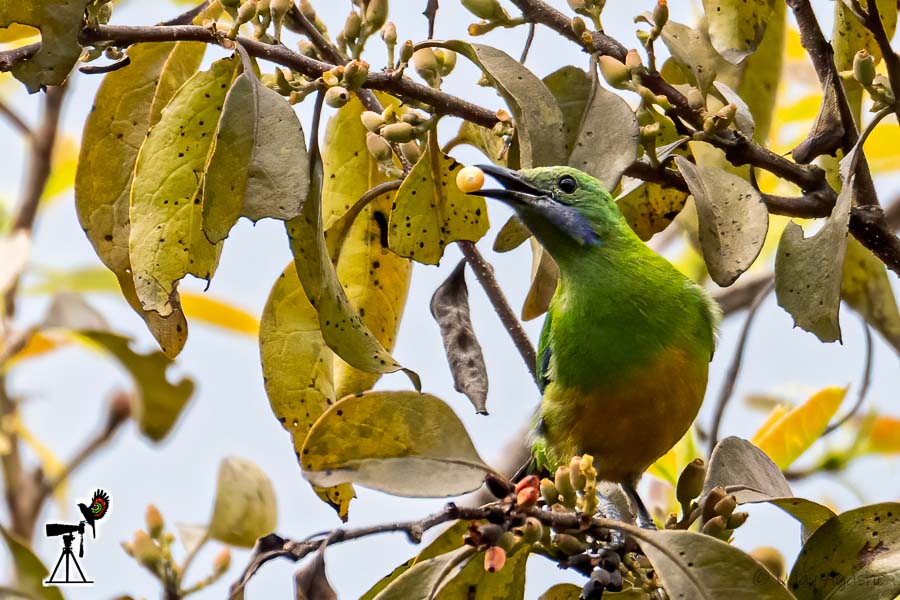
Orange-bellied Leafbird
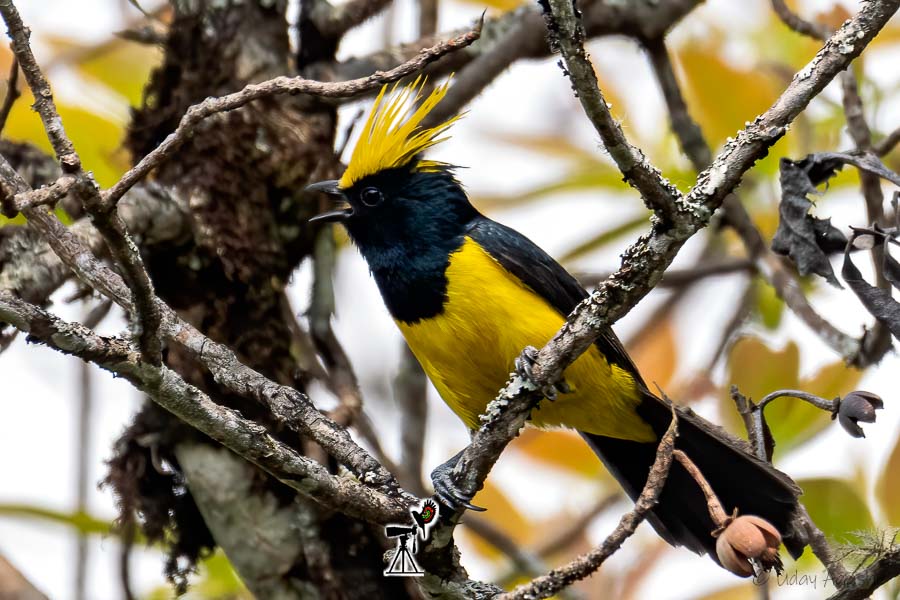
Sultan Tit
It was close to 1pm when we decided to start our return journey, on the way back up to Lava, we did see a few other (now) common birds but didn’t get down. Sky was also getting cloudy so we decided to go straight for lunch.
As soon as we entered the restaurant (for a lunch of momos & some Chinese veg preparation) it started raining outside. It was raining in Lava whereas Rishyap (our stay location) appeared dry. But a few minutes after we entered our rooms, it started raining heavily here too. It rained for an hour and by 5pm there was some sunlight. We tried to move around the place but couldn’t see anything special. Ended up taking some selfies with the drone that Abhay was carrying and called it the day.
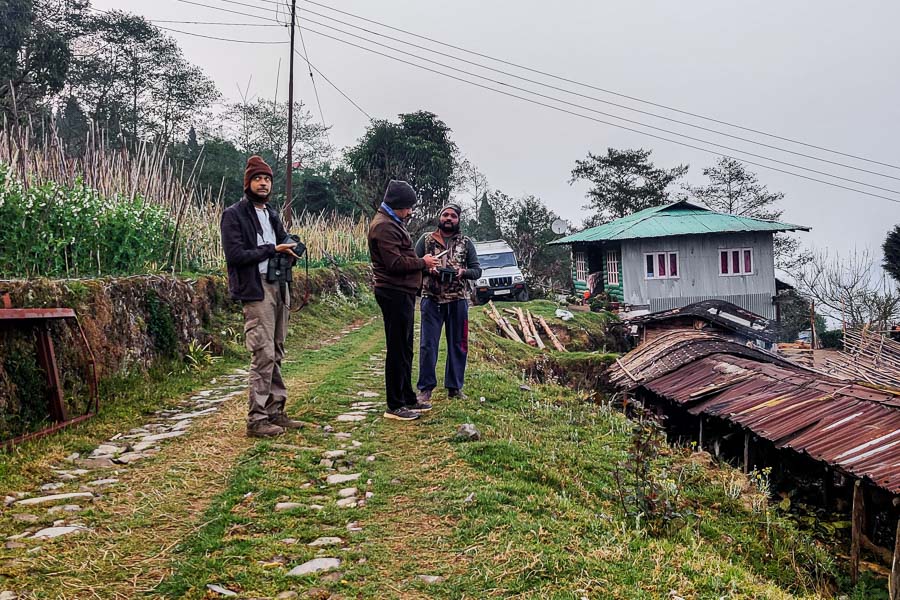
Checking the surroundings
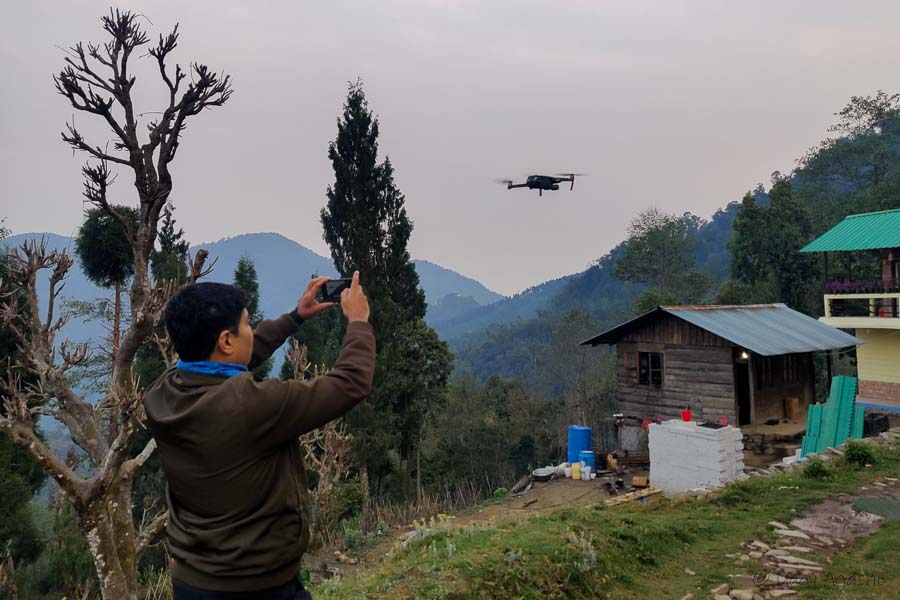
Sameer with Drone
5th April - Day 4
Today our plan was to spend the morning hours birding in the nearby areas and then travel to Latpanchar. Once again, we started at 5:30 and decided to take the path up the hills for birding. The usual minivets, redstarts and verditers were there to greet us. Even the green-backed tit & some doves were seen today.
There was one area near the Lovely hotel that seemed to be the favorite spot for Golden Bush Robin and there were already some photographers lined up near it. We also decided to join them. The robin did come after some wait but it always remained inside the bushes, never coming out in the open. It was fun to watch all photographers moving from bush-to bush behind the bird and it kept eluding all.
While we were at it, Abhay just pulled us aside and talked about going further up the hill, to another spot in search of the sunbirds again. So far, we had missed the fire-tailed sunbird and there was a chance of seeing it here.
We took the cue and moved quickly. We were in luck; within 10 minutes we did see the sunbird. It was the green-tailed one but little later, the fire-tailed sunbird came out and perched on the near-by bushes.
As we moved from there to a lower level, we were able to see another fire-tailed sunbird along with the Russet Sparrow.
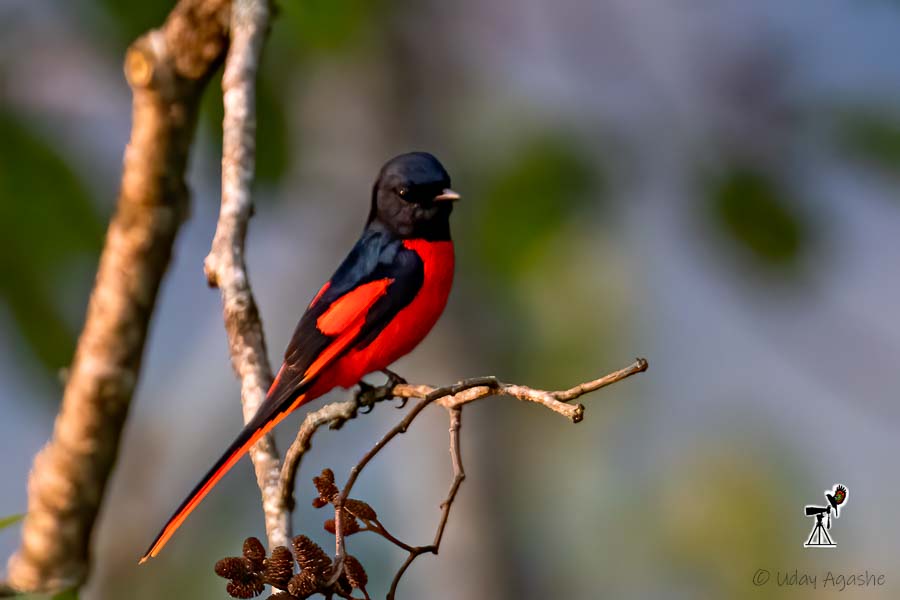
Minivet
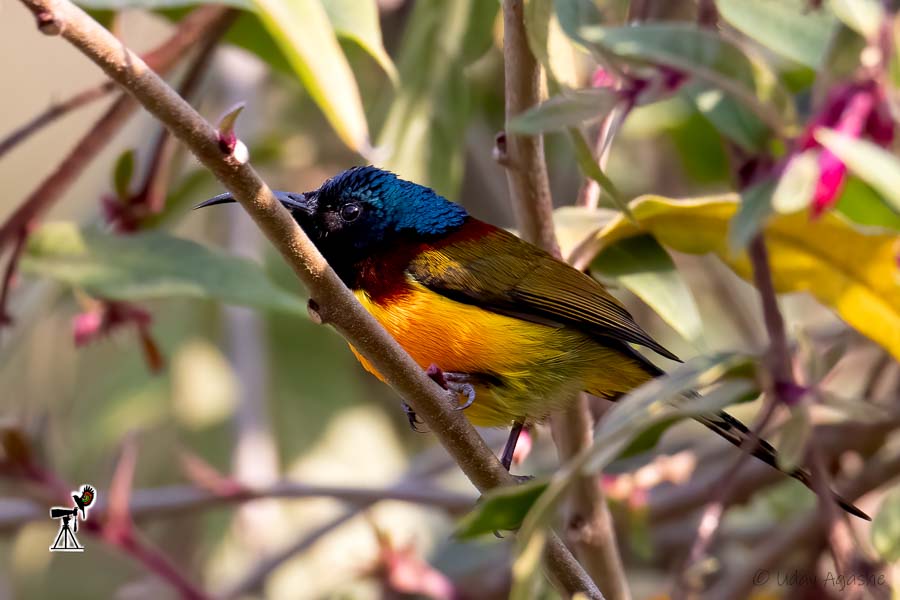
Green-tailed Sunbird
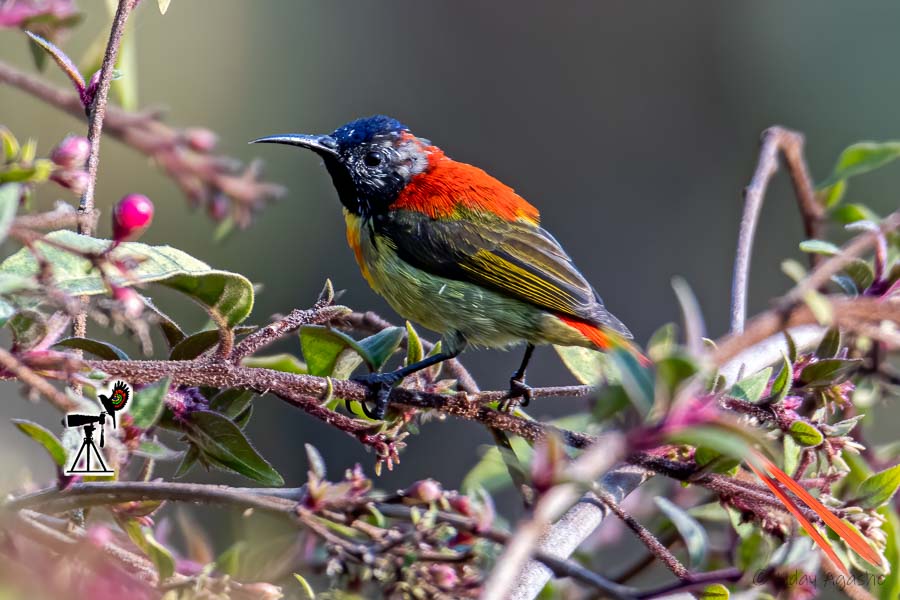
Fire-tailed Sunbird
It was around 8:15 and time to get back to our resort. On the way back we again saw some verditer
Back in our home stay, we quickly had our breakfast, the bags were already packed. We were now only waiting for our vehicle. This region has its own rules for the allocation of driver/vehicles. They have a syndicate that does the allocation and although we wanted to go directly to Latpanchar, they arranged two difference vehicles (since the districts were different). Abhay assured us that for Latpanchar part of our trip, he has arranged for a driver of his choice for all the 4 days.
Just as we were leaving, there was a raptor in the sky and I quickly got my camera, it turned out to the Black Eagle.

Black Eagle
We started by around 11am and drove via the Kalimpong town. The area had some political rally and resultant diversion of traffic (Elections in that part were to be held on the 17th April). That resulted in a long traffic jam and we ended up spending more than an hour to cover about 2 kms in the city.
The journey was full of ghats, it was a nice experience (Especially since I did not have any motion-sickness on the way). For a lot of distance, we were travelling along the Tista river. The flowing water was presenting a nice view.
During this journey, at one point I saw a different bird perched on a tree. As such the area around Tista river is sensitive and getting down from the vehicle for photography was avoidable. But here we took a chance and got down. It was the common hill myna but as I was taking some snaps, Abhay saw another bird and he alerted us about this rare bird. It was the black-crested bulbul.
At Kalijhora junction, we moved away from the highway and once again our birding journey started (all the way till Latpanchar town).
As we started moving up, our attention was drawn to the orange-bellied squirrel on a nearby tree. Although we had packed our bags, the cameras were kept handy and that was useful now that we started seeing the birds again.
Further up, we were able to spot few more birds. First among them was the blue-throated barbet. The fruiting tree was like a magnet as some other birds were also seen there. Once again, we saw the Black-crested bulbuls. We could also see some orchids flowering in that valley. Little further we were able to see the first owl of the trip, the Asian barred owlet.
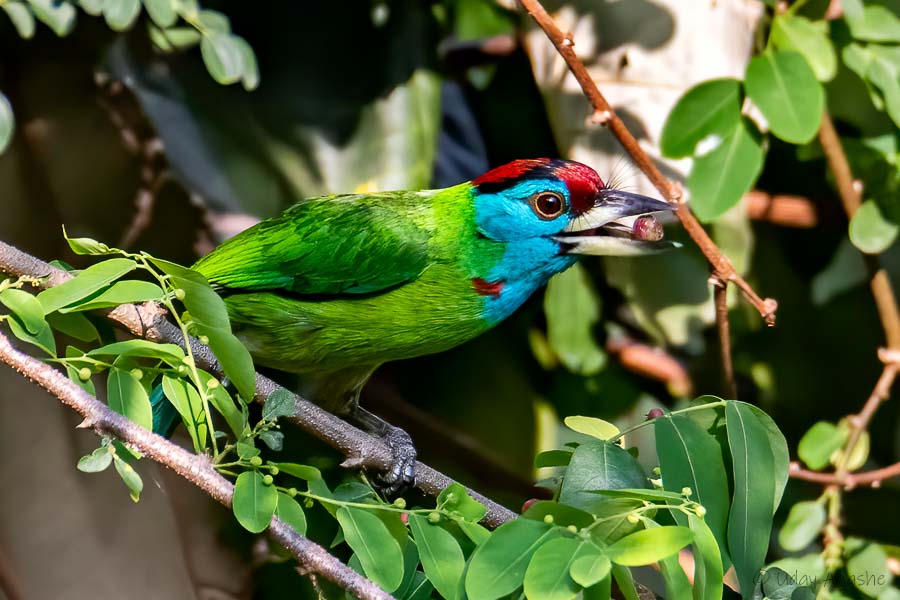
Blue-throated Barbet
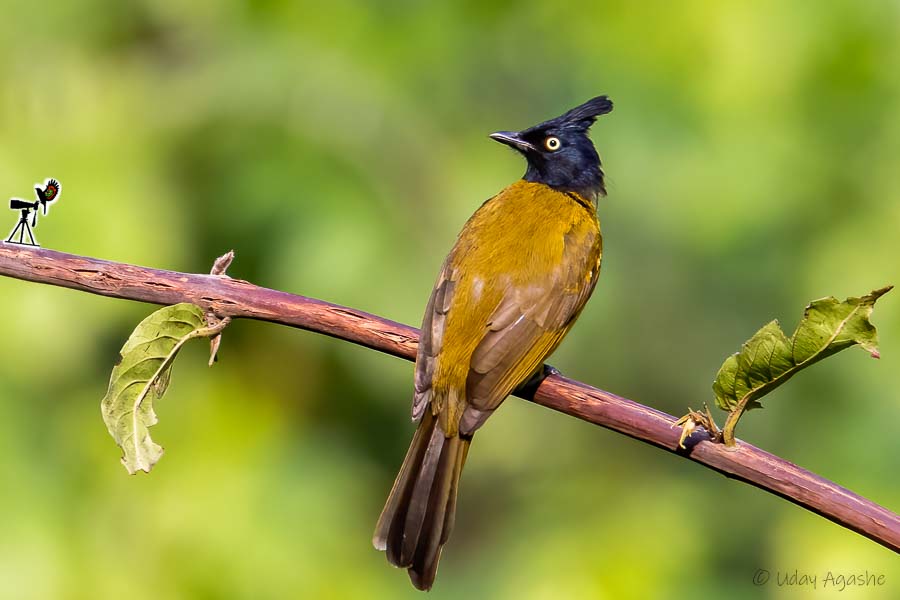
Black-crested Bulbul

Asian Barred Owlet

Orange-bellied Squirrel
With all the birding (and traffic) on the way, we reached our destination only by 4pm and the hosts were waiting to serve lunch. But we thought of taking a chance to see the Hodgson’s frogmouth while there was some light. It would be too late if we spend time on lunch. We somehow convinced our guide (Suraj) to take us straight to the spot without even unloading our bags.
On the way, the guide told us that recently some wild elephants were seen in that region and we should be very careful.
Suraj guided the driver to a particular spot and before we realized, he was going deep into the valley thru a small pathway. It looked slippery and getting there with our heavy camera/tripod equipment looked tricky. I had heard about this difficult trail from my friend Pallavi (she had been here few days before), now I realized what she really meant.
We started moving down but just as we had covered a few meters, Suraj came back saying the birds are not there now and our trail will be futile. So we once again got into our vehicles, but Abhay and the guide decided to walk looking for some other birds. It was pure luck when Abhay sighted a pair of Red-headed trogons perched not very far from him. As there was no phone connectivity here, Suraj started running to call us (we were waiting in the vehicle at some distance). By the time we reached the spot, the birds had already flown down. Since it’s a rarity, we quickly took a few snaps anyway.
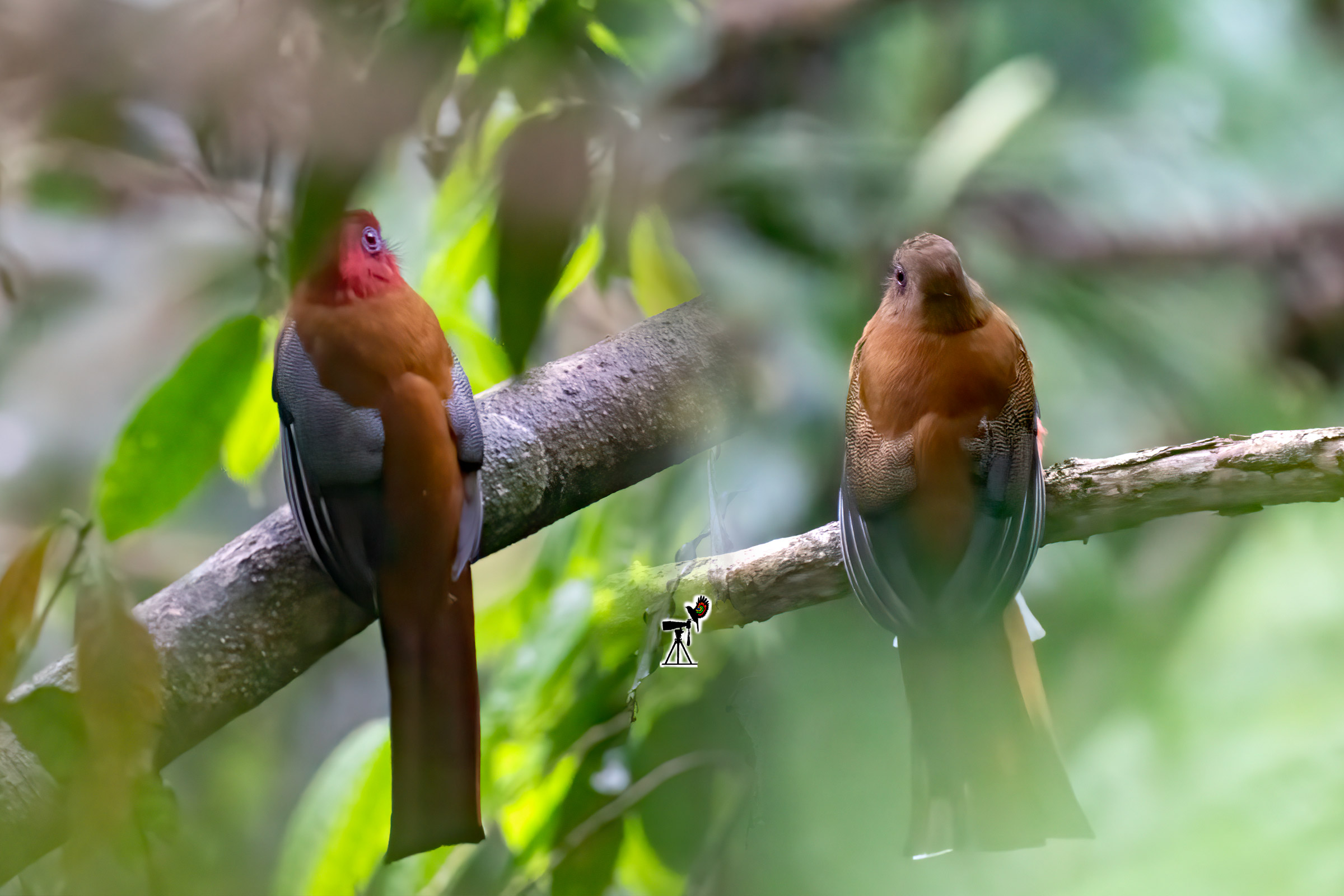
Red-headed Trogons (male/female)
On the way back, our guide mentioned about another possible location for the Frogmouths so he asked us to wait while he went ahead and checked the spot. He came back in 10 minutes confirming their presence and we started that trail. It turned out to be a much worse trail (the most dangerous I have ever walked in my life).
We were trying to walk with help of trees on that slope (with a deep ravine on one side). First few meters were peaceful but then I stepped onto a patch where the soil was loose and I lost my footing, went 2 feet down along with my camera gear (all properly dusted) but luckily my fall was arrested by some shrubs. Managed to get on my feet and continued on the trail for some distance. But within few minutes, I realized that things were getting even more difficult and decided to stop mid-way. Me and Sameer both stopped there while others went ahead. They somehow managed to click a few snaps in that low light and the dangerous conditions.
Getting back from that place was no less ordeal, I had another false step but otherwise we were back to our vehicles safe! Lesson for me: no point in taking such undue risks.. it’s alright to miss some birds
Journey back to Home-stay was uneventful. We had a nice welcome tea and unpacked quietly. It was around 6pm and we realized that after our breakfast in Rishyap at 10am, we did not have anything (except for few oranges of local variety on the way). Luckily, they had prepared some bhajiyas for snacks (as dinner was to be served at 8) which was a most welcome thing at that moment.
This homestay was also on the edge of the valley and although the town looked more modern, there was no mobile connectivity (only BSNL works in that area!!).
The place seemed to attract a lot of moths so my macro lens was put to good use that evening.
6th April - Day 5
Today, we started by 6 (little late compared to earlier days).
Our guide told us about the recent sighting of the Rufous-necked Hornbills pair. They had apparently found a suitable nesting hole and hence all the local guides were hopeful that the birds will come there. As per their judgement, the pair was likely to come by around 10/10:30pm (based on previous days observations). We therefore had sufficient time to look for other species.
As soon as we entered the valley area, we sighted the Large Cuckooshrike. Light was still not good but just sufficient for Suraj to id the bird.
As we went further down, we reached a small plateau (not a large one but just enough where a few vehicles could be kept). It was such a lovely view all around that morning. All sides were covered by green mountains and the valley had some flowering plants as well.
We were greeted by a pair of Himalayan Black bulbuls. Soon the Sultan Tit made its presence felt by way of repeated calls. While we were busy capturing its poses, another blackish birdy flew and perched close to us. It was the Hair-crested drongo.
At some distance we could spot the minivets and the olive-backed pipit. Suraj looked thru the binocs and confirmed that the minivet was Grey-chinned (another lifer). Then came the Woodshrike and the pygmy woodpecker (Brown-headed one).
With so many birds on display we were very happy. Suddenly Suraj alerted us about calls of Asian Emerald Cuckoo, I had heard about this colorful bird and so was very excited in anticipation of its darshan! And the cuckoo didn’t disappoint. It perched perfectly on a tall tree that was standing right on that plateau (many of us were standing close by but the cuckoo was undisturbed).
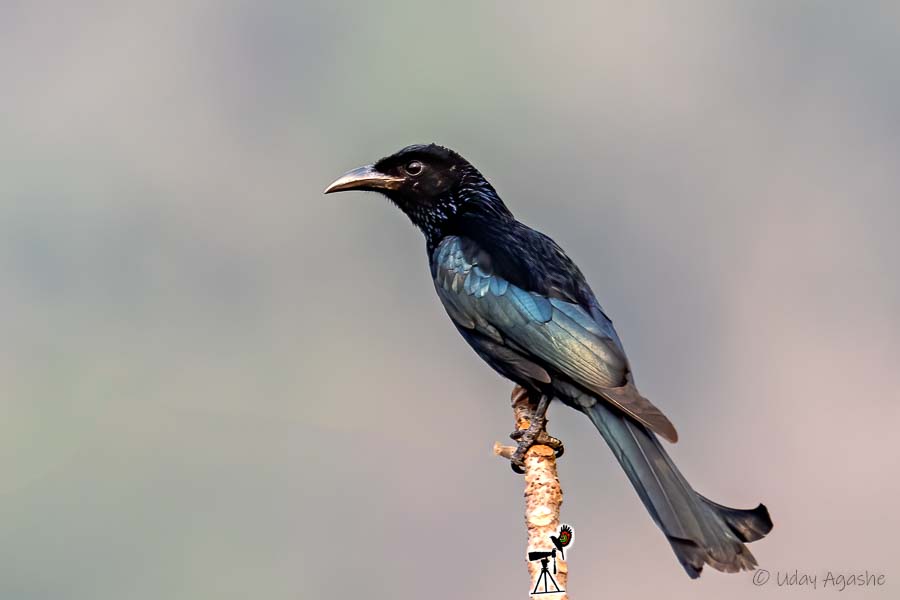
Hair-crested Drongo
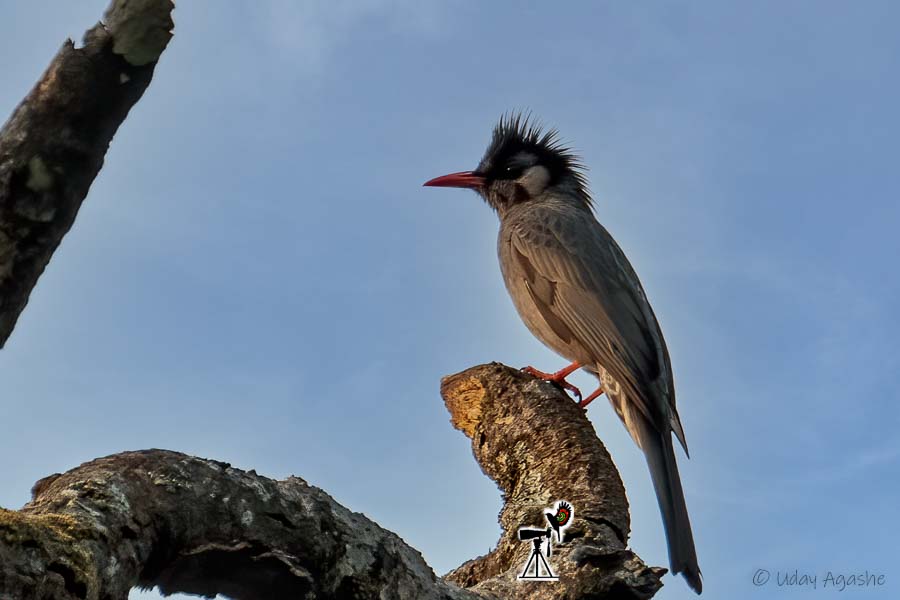
Himalayan Black bulbul
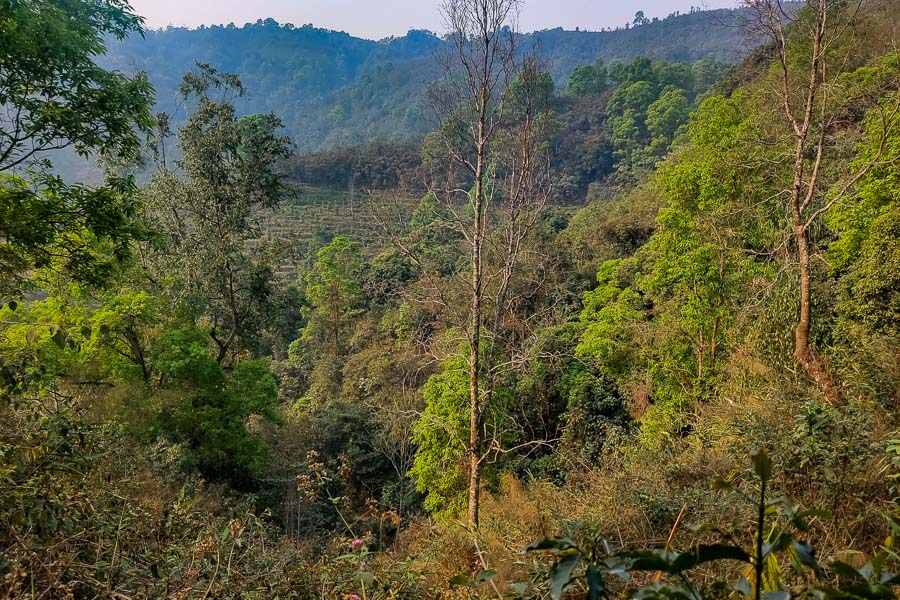
Mahananda Valley

Asian emerald cuckoo
With that very good photo session with cuckoo, Suraj took us on a small trail (considering yesterday’s tricky walk, these trails were very easy). We did not go very deep inside (may be about 100 odd meters). This place had good butterfly activity as well although we did not have any expert with us to help with their identification.
We could see a few more minivets followed by the Blue-throated barbet. But the star attraction was definitely the Maroon Oriole. There was a pair and they were flying near us but unfortunately decided to perch on a far-off tree. Whatever be the distance, the lifer had to be captured anyway!
It was close to 8:30 and all along we were either walking or standing, so we decided to catch some breath in that nice cool air.
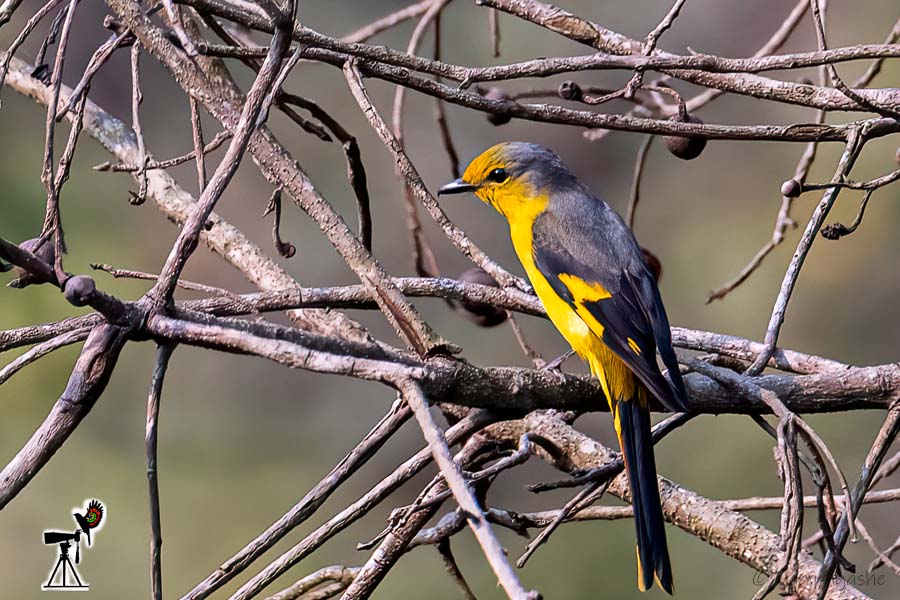
Minivet-female
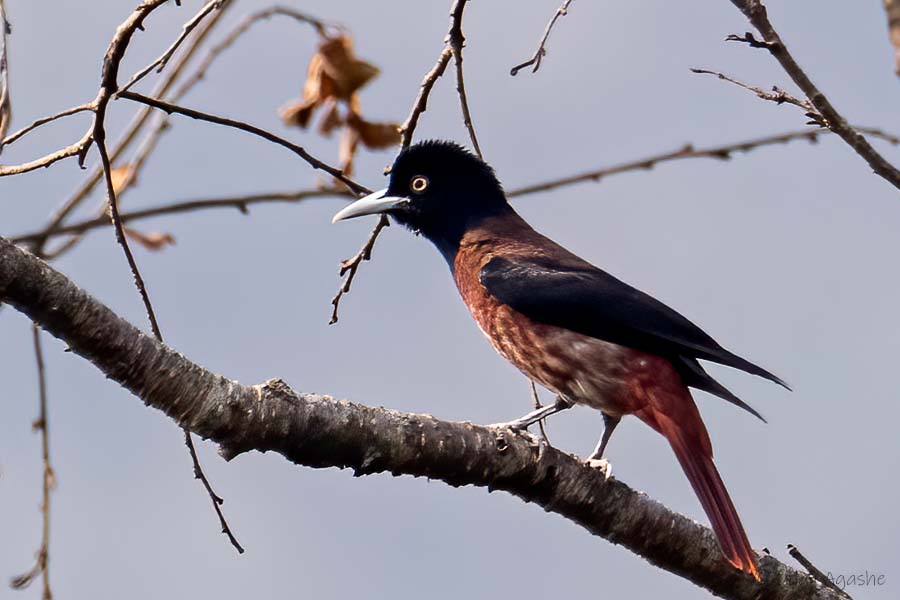
Maroon Oriole

Prashant, Suraj & Sameer
By 9am, Suraj took us back to the plateau and started for another trail, this one was little tougher (but not very dangerous) and the target was the Hornbills. He wanted us to be ready on the spot by the time the hornbills arrive. We all followed him (there was just enough space for one person to walk, so it had to be a line). It was a long walk and as we kept going in, the vegetation got denser.
At one point, the guide showed us 2 small birds deep in the trees, these turned out to be white-throated Bulbuls (another uncommon one).
We continued to wait there for long and while there was no sign of the Hornbills, we were able to see some special species from that spot. First was the yellow-vented warbler, then the beautiful Paris Peacock butterfly followed by the Black-throated Sunbird (which we had seen cursorily in Changay falls trail).
On that trail, we had created a small traffic jam (for some of the locals, who routinely go down into the valley using that path - possibly to collect wood and other forest produce). There were 2 other groups (and their guides) along with us waiting at that spot.
By 11:30 (almost after two and half hours of wait), all of us realized that the chances of seeing the hornbills were close to zero (and we were hungry too.. after getting up at 5, we have only had a cup of tea so far). Little reluctantly, we moved out.
And as we were returning back, we managed to see another lifer, the Pin-striped Tit Babbler.
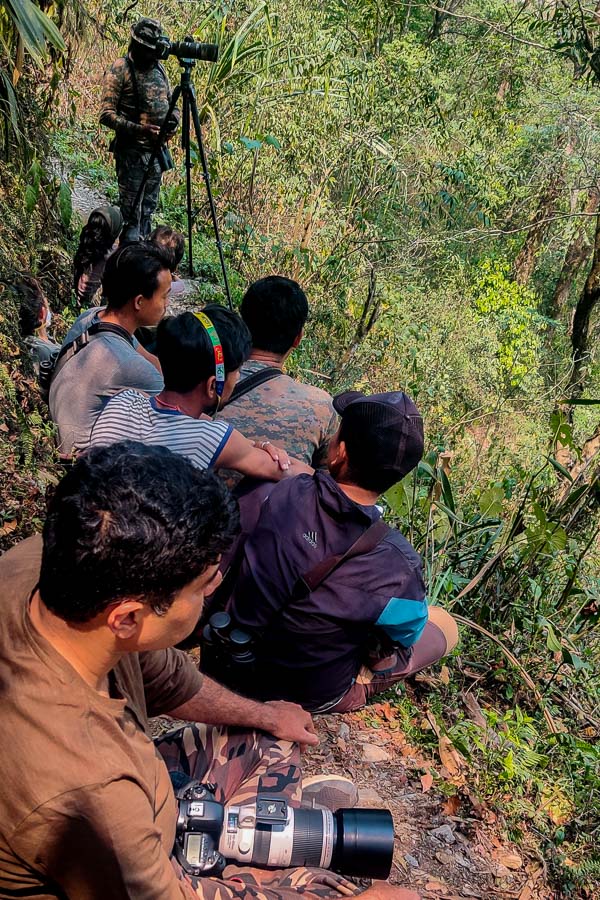
Just enough width
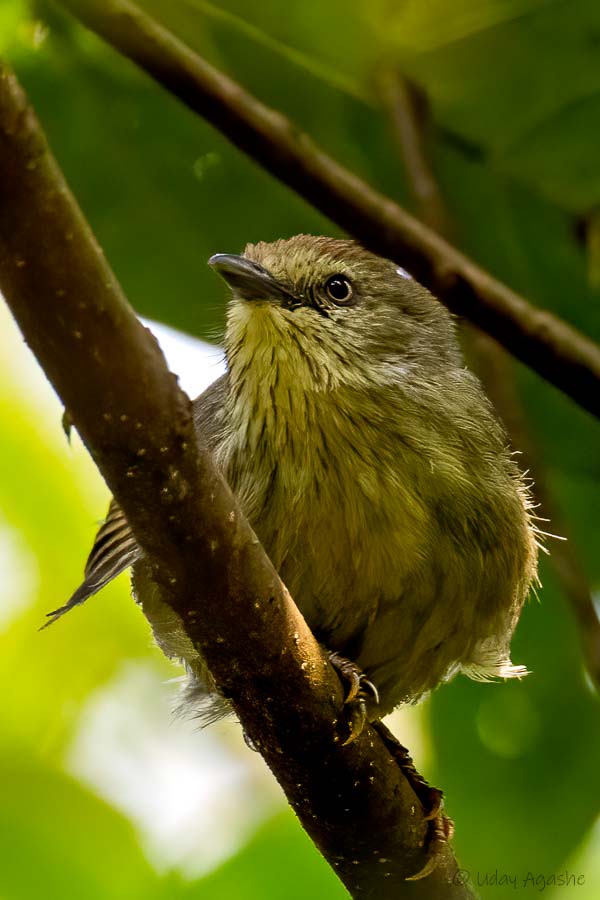
Pin-striped Tit babbler

White-throated Bulbul
We were back to our home-stay by 12:30 and had our brunch.
We took a little break (legs were tired with all the walk) and moved out once again by 2pm (by 5 the lights start going down, so we could not delay it any further). For afternoon our birding spot was the ghat section of the road (called Nursery.. don’t know for what reason) which apparently is a very good birding spot as per Abhay. But soon we realized that because of the recent road construction work, the entire habitat was disturbed and it was difficult to find the birds (which till a couple of years back could be seen very easily from the road itself).
For afternoon our target was the Long-tailed broadbill (or Helmet-wala as it is popularly referred because of the typical pattern on its head). We got down near a dried stream, plan was to walk from there along the road as this was roughly the spot where the broadbills were likely to be seen.
As we got down, Prashant spotted some bird activity down in the stream (all through the trip, he kept on finding birds with his binocs- he was not carrying camera and was more than happy to just observe them). It was the Slaty-backed Forktail. On a nearby tree, we also spotted a nuthatch & a woodpecker.
By this time Suraj had walked ahead and seemed to have found a small flock of broadbills. He called us and we all ran along with super excitement. There were 3-4 of them but they were just so far and that too hidden in the leaves, it was impossible to get any meaningful photos.
Then Suraj took us on another exhausting trail. This time instead of going down into the valley, we were going up thru the vegetation and trees (carrying the heavy load is so tiring in such situations, every few meters we had to bend down to avoid the branches, keep making way thru the deep vegetation.. but it was fun too). The sad part was as we kept moving, the birds were moving too!! And it was impossible to keep pace with them (they kept flying a few meters and with every such move, our troops tried to keep pace).
There were moments when we could see the bird clearly but only for a few seconds (before they made the next move). This hide-n-seek game went on for more than an hour. In the process we did get a few record shots but by then the birds had moved beyond our reach and we had to remain content with whatever we could.
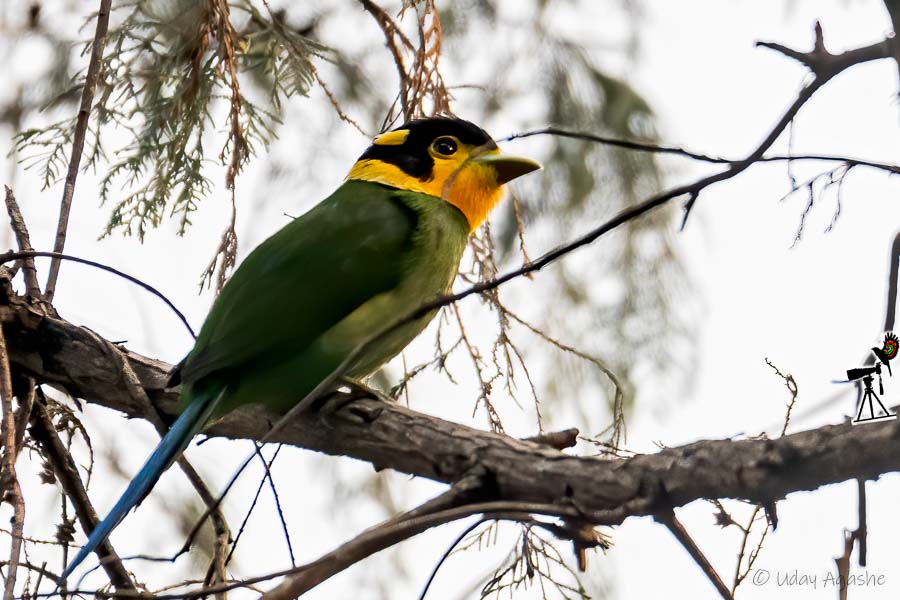
Long-tailed Broadbill
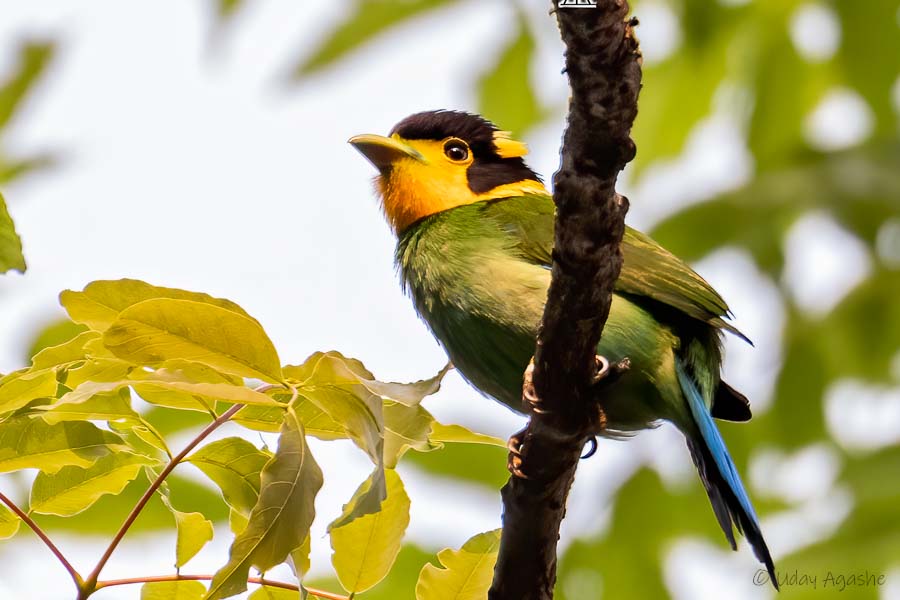
Long-tailed Broadbill
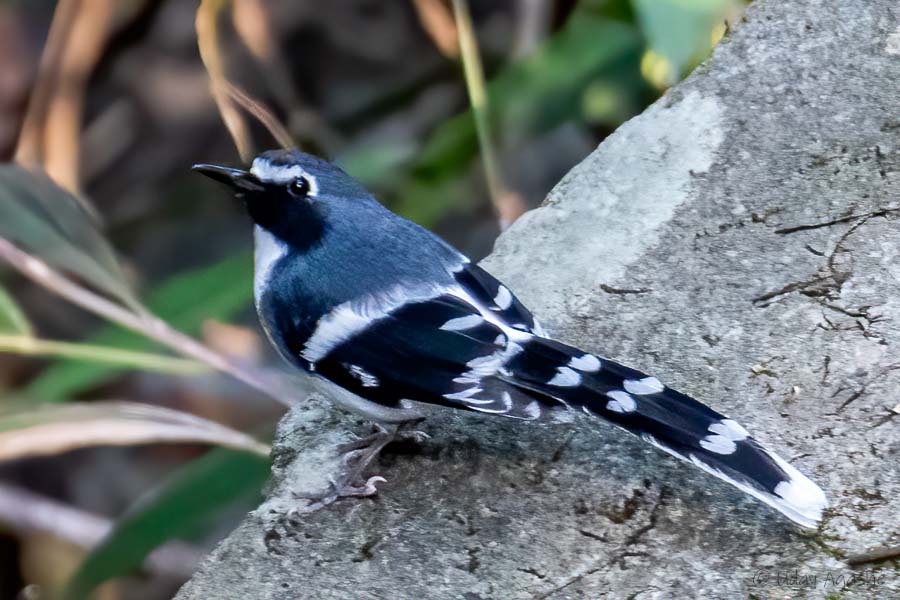
Slaty-backed Forktail
While all this was happening, our driver thought we had gone down the road and hence he drove the vehicle in search. The phone connections were not working and we had no energy left to walk down (at least a km). We just dropped on the road and asked Abhay & Suraj to somehow fetch the vehicle back. Poor guys, they did walk down and called back the driver. Back on the seats and after some sips of water, we regained our enthusiasm for more birding.
Just round the corner we were able to see the Black Bulbul and the Asian Barred Owlet. But other than that, we could not see any activity.
By 5 pm, we decided to return back. As we were traveling thru the village our guide met some villager (his local friend) and came to know about possible sighting of the hornbills there. We all got down from the vehicle and started on another wild-goose chase. We kept going down at full speed (whatever that was possible for us city-folks…. Because our guide had gone much ahead). By the time we reached the spot, the bird apparently had just flown, only Suraj could see it. Once again, we came back empty handed.
While coming up we had the realization of how far down we had gone. It was big effort (specially in that low oxygen zone). Just as we were about to reach the road, Abhay heard the calls of Common Green Magpie. For those of you who are not much into birding, this word “common” can be a big misnomer. Lot of these so called “common” birds are very uncommon and are always a prized catch if you can get a photo (some examples Common Starling, Common cuckoo, Common Quail, Common Shelduck, and so on..)
We tried to look at the trees ahead in that low light but could hardly make out the bird anywhere. After 5 minutes struggle finally managed to get a record shot (just good enough to identify the bird).

Common Green Magpie
That was the last for the day, overall a decent day although we missed the Rufous-necked Hornbill.
Tomorrow we planned to cover some remote areas and hence had to start early. Keeping that in mind, we slept off at 9:30 itself.
7th April - Day 6
Our plan today was to cover wider areas including Shivkhola, Rongtong and if possible Lepchajagat & Paglajhora. But there was some political rally on the way (we came to know about it during dinner time). So we left it to our guides to decide on specific locations to visit.
We started at 5:45 and were going to the Shivkhola region first. As we started moving up the hill (this road was going via the top of the hills where Latpanchar was situated), we saw the Blue-capped Rock thrush and the Tickell’s thrush. From there on, we kept on getting down from the vehicle every 5-10 minutes because of the bird activities in that region.
The Hill Mynas had occupied a nice perch but didn’t wait long as we were getting down from the vehicle. But then we were able to sight the Blue rock-thrush, followed by Common Iora (it got disturbed by a speeding vehicle on the road). Here once again we heard the calls of the Common Green Magpie. And again, we were only able to just see it and get some record shots. Then came the pygmy woodpecker and the Great Barbet.
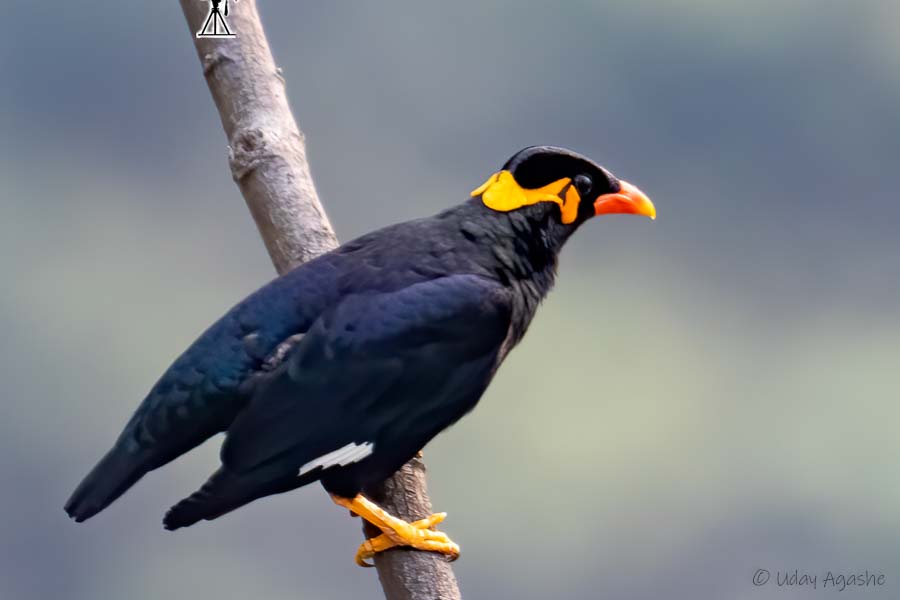
Hill Myna
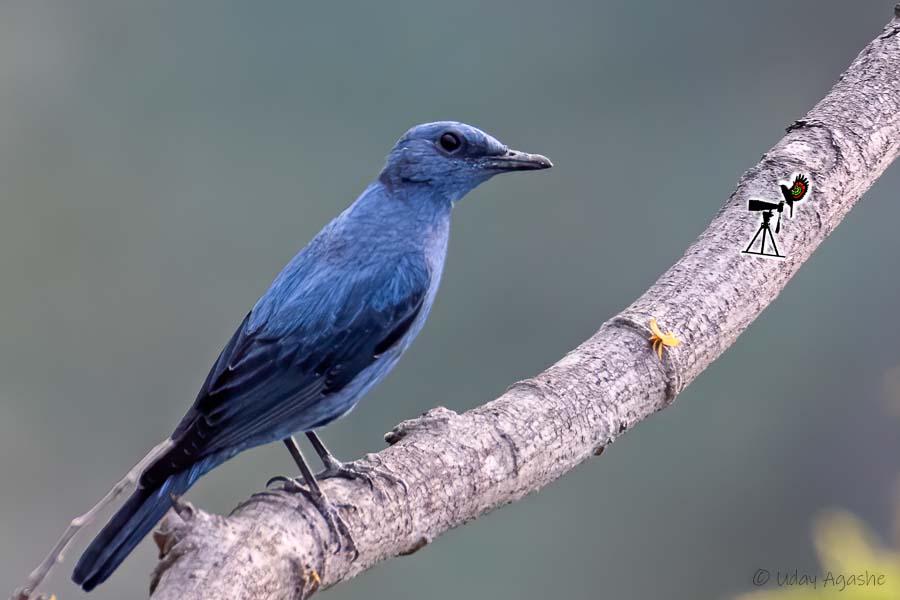
Blue Rock-thrush

Common Iora
Another 10-15 minutes journey by the vehicle and we again stopped because of the blue-throated barbet. The pair was busy taking turns in building their nest cavity. As they were busy, they allowed a better approach towards them and hence we could get some good photos.
All the while we were only looking for birds around the trees but we had by then reached an area that was full of tea plantations. We could also see the villagers plucking onto the tea-leaves. Just as we were observing the plantations, there was a blackish bird with long tail. It was far but we decided to go near it thru the tea plants. We kept the chase on for next 15-20 minutes, wading thru the plants. Got only a few long shots in the end as the Green-billed Malkoha kept moving further away.
It was 9 o’clock and we were still just passing the Shiv temple at Shivkhola (khola means river in the local Nepali language and the Shiv temple there, gets the name). We crossed the bridge over the river and again stopped. It was time to observe the 5th sunbird of the region, the Crimson Sunbird.
This region also had a lot of bird activity and we could see the Black-crested bulbul, long-tailed and scarlet minivets, the brown-capped pygmy woodpecker and also a few butterflies. There were also the nuthatches, and the leafbirds.
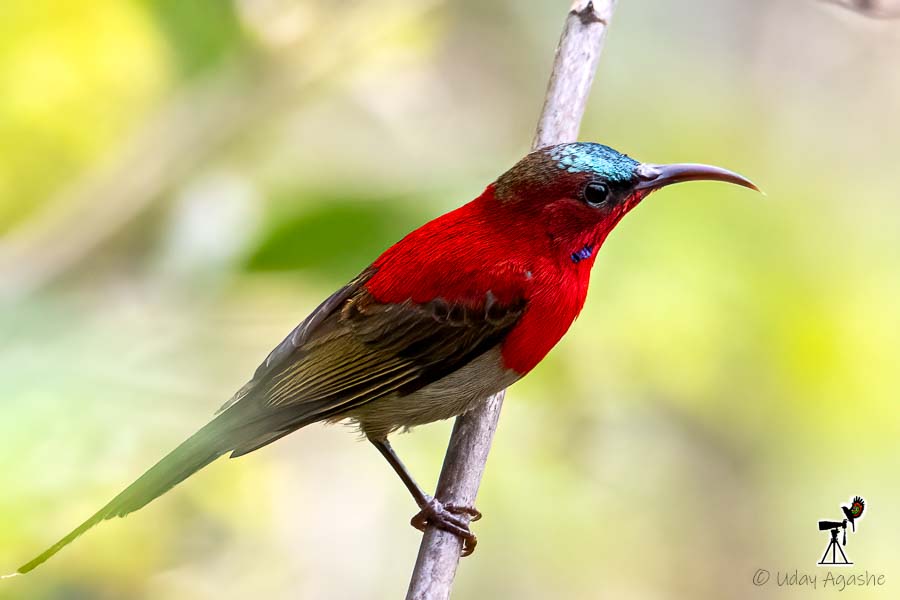
Crimson Sunbird
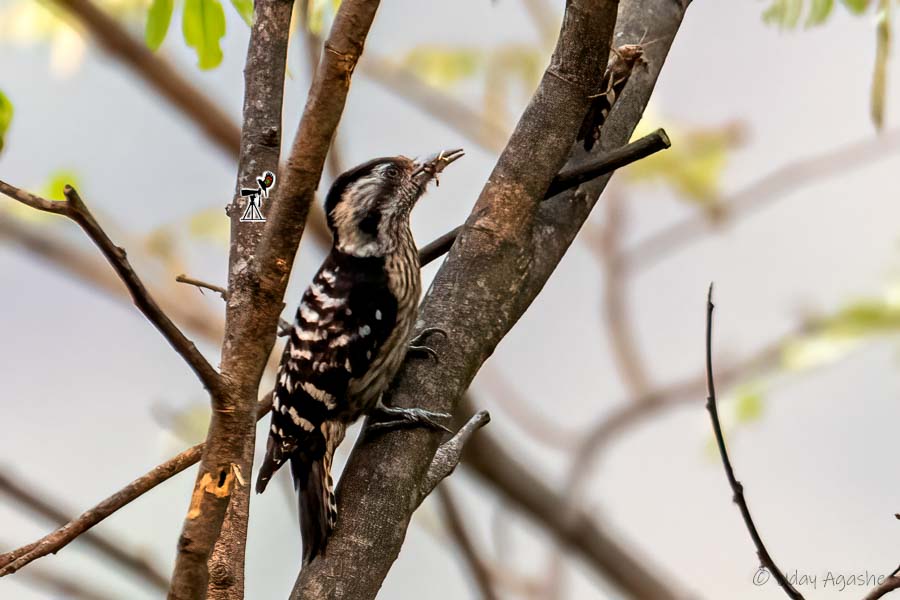
Pygmy Woodpecker

Blue-throated Barbet
We were now moving towards Rongtong (target was to see the Great Hornbills). But at one point, we had to make a compulsory stop as road-construction work was going on. The roads there being small, they had stopped the traffic altogether. Luckily there was a small stall that was serving tea and maggi type snacks. It was 10am and we were very hungry anyway.
We saw some of the locals having a green-peas gravy (something like the Usal of the Usal-Paav that we get in Mumbai). While the maggy was getting ready, we decided to try that local dish. Our hunger and fatigue meant anything was tasting great that time.
With full stomachs, we began our search for the Great Hornbills once again. From then onwards till about 2:30 we covered a lot of ground (could see some more minivets, a Himalayan griffon vulture and the black-winged cuckooshrike) but there were no signs of the honrbills. Suraj, our guide tried tapping all his local sources too but no luck!
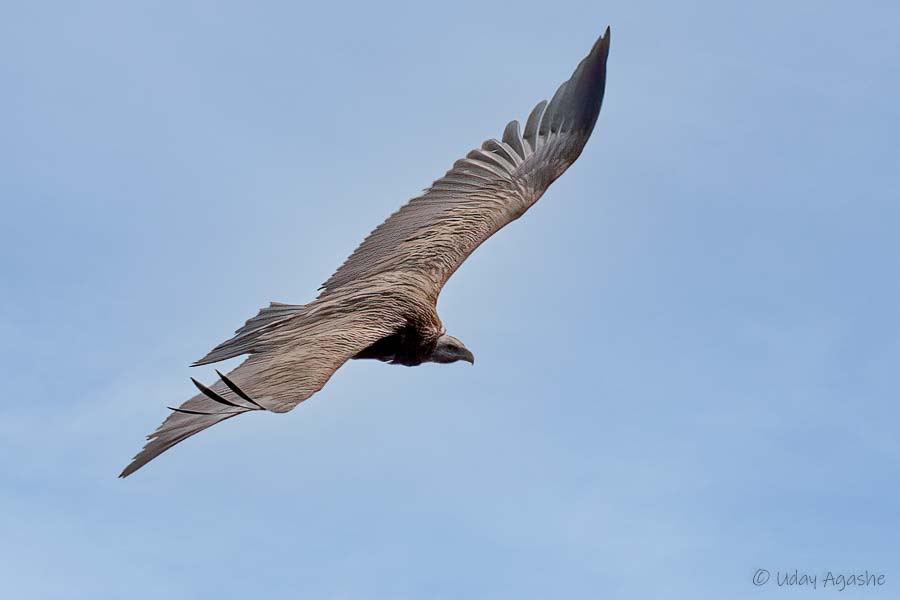
Himalayan Vulture

another Minivet
Finally, at 2:30 pm we decided to break for lunch at another local joint. After lunch, we started our return journey with zero hopes of seeing the hornbills (looked like we were not lucky with the hornbills, yesterday the Rufous-necked hornbills tricked us and today it was the Great Hornbills).
With the tiredness (and some frustration), we were having less stops in the return journey. It was close to 4pm and the light had also started reducing. While we were traveling back in the hills, on one of the turns, I noticed a big bird flying across and shouted loudly “Hornbill”!! Suddenly everyone became alert.. it was a pair of hornbills flying across. Now Suraj took control, he had a fair idea where the birds would land and he instructed the driver accordingly and this time he was spot-on. We got to click both the male and female from a decent distance.

Great Hornbill - Male
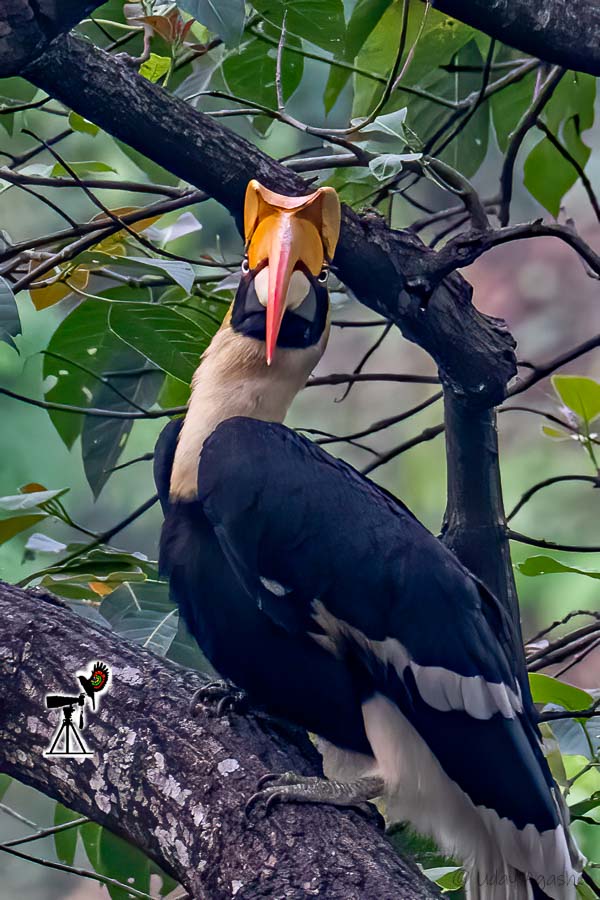
Great Hornbill

Great Hornbill - Female
After that fantastic sighting (especially when we had lost all hopes) we decided to have a tea break at the same stall where we had breakfast in the morning. It had another attraction, the owner had mentioned that the place where he throws the leftovers, was frequently visited by the neckless thrush. So, we could take a chance.
But as we were settling down, one other birding vehicle coming from other direction told us about a pair of Black Baza seen in the valley, so we immediately changed plans.
We did go the distance but could not see the Bazas, instead we saw another pair of Great Hornbills. And they were engaged in a courtship display, although light was low, I managed to get a video of the action.
Back at the stall, we had Tea but also got the bonus of Chestnut-headed bee-eaters and golden-fronted leafbirds.
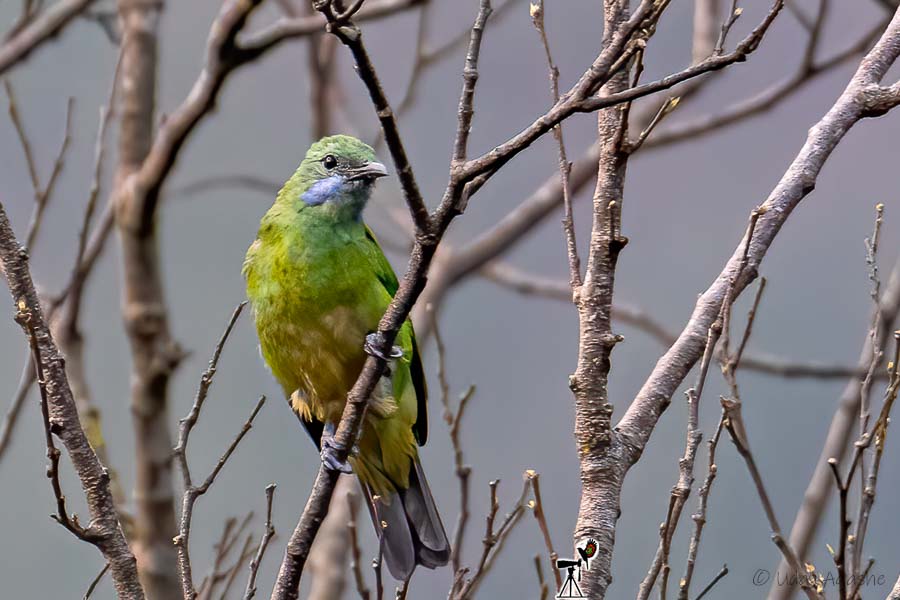
Leafbird
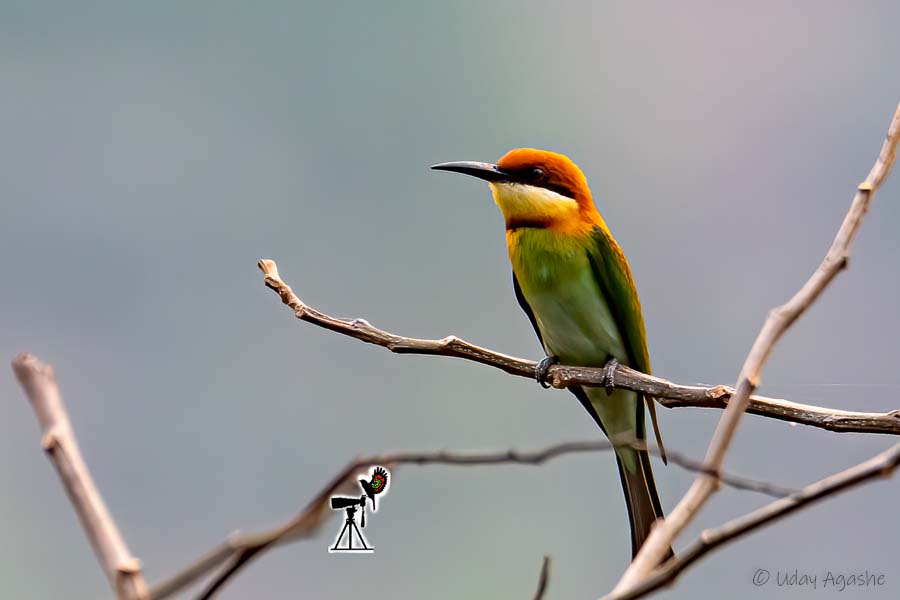
Chestnut-headed Bee-eater
The funny part was we struggled thru the day for Hornbills and when we finished our tea, the Hornbill was perched right next to us on a tree. There were loads of people below but the bird was not disturbed at all
By then it was already 5:30 and we had a lot of distance to cover. Traveling thru those bad roads (and the roads were really bad in this section) with no street lights was a risky thing. But our driver was experienced one and he was very careful too.
During that journey we had another fantastic sighting. It was dark but in the glow of headlights, we saw a Leopard cat (a super rarity, all of us were seeing it for the first time). The excitement was so much, nobody even bothered to take out cameras, not even cellphones!!
We were back to our hotel by 8:15, and it was straight-away time for dinner.
8th April - Day 7
Today was effectively our last day of trip because of the change of flight schedule on 9th. Our initial flight was at 7 in the evening, so that would have allowed us the morning birding session but it got rescheduled to 11am eliminating any chance of morning birding. But good part was it was a direct flight to Mumbai (earlier one was with a stopover at Delhi).
We started the day little late (by about 6:30) and plan was to have another go for the Rufous-necked Hornbill. As the hornbills were likely to be there only after 9:30/10, we decided to spend some time on the roadside trail (like our first day here).
Once again, we started with the blue-capped rockthrush, some minivets, woodpeckers and also the chestnut-tailed starlings. We also saw a nicely perched leafbird and the bar-winged flycatcher-shrike guarding its nest.
Then came the nice display of the fire-breasted flowerpeckers. The male was calling from close distance and we could do a nice video as well.

Bar-winged flycatcher Shrike
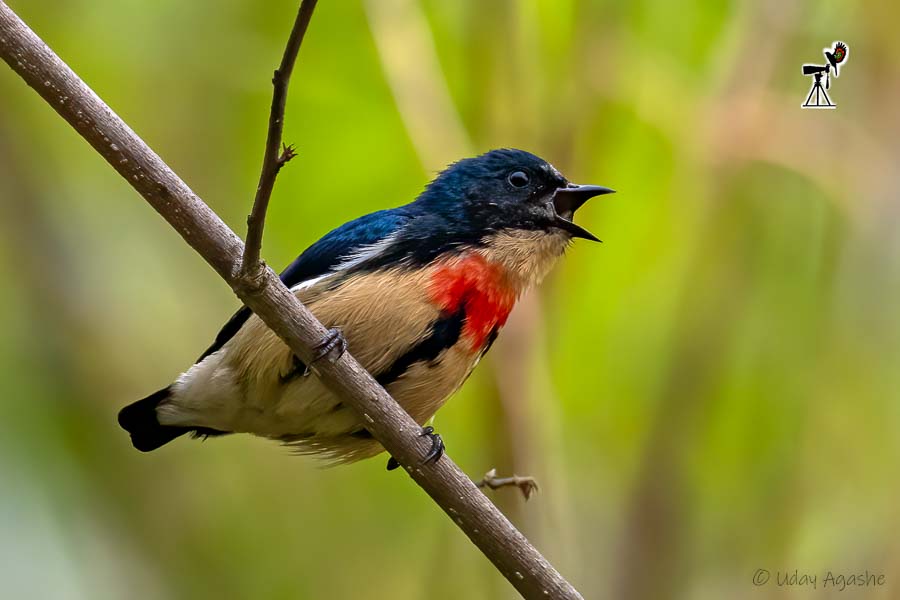
Fire-breasted Flowerpecker
By 8 o’clock we decided to move back, just as we were doing that, we saw some action in the valley below. It turned out to be a flock of green pigeons. That was a mixed flock of Wedge-tailed and Pin-tailed green pigeons (both I was seeing for the first time anyway).
Before going for the hornbills, we decided to have a quick breakfast and it was a sensible decision because the wait for hornbills was likely to be a long one anyway.
While having breakfast, we were able to observe the barn swallow activity close to home.
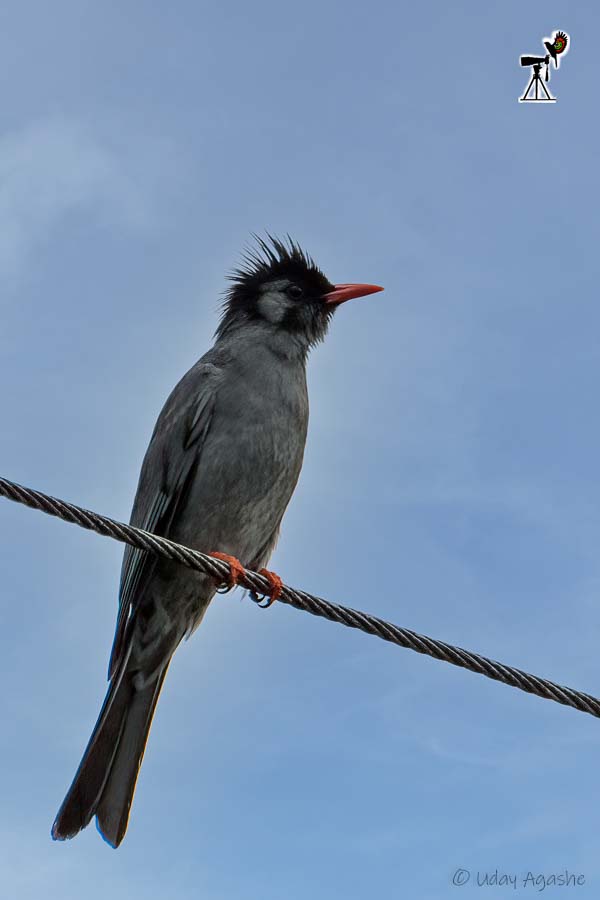
Himalayan Black Bulbul

Barn Swallow
By 10am, we were again on the trail for the rufous-necked hornbills. There were other groups as well so we decided to move immediately on the trail. Within 15-20 minutes we were ready on the spot. Some others decided to go further down in the valley getting little closer to the nest tree and that turned out to be a good decision for them as the birds did come and they perched in the canopies (so we were not able to see them clearly from our position).
Finally, even we moved down in the valley and then stay-put there for more than an hour. As the birds kept changing perches, we birders kept changing our places. Every one of us was trying to get a better angle, waiting for the right opportunity.
At one point, I actually missed a very good one. The hornbill had perched on a tree in a clear view, but in the excitement, I missed simple photos… was not able to keep the tripod steady (we were in the valley, and tripod legs were kept at different heights to adjust to the terrain) and ended up taking hazy pictures.
Anyway, in the end we managed to get some snaps of the lifers. Till that point Abhay was really worried because this would have been his first ever tour (from 2011) where the Hornbills were not seen. And he got saved by a whisker because this was the last opportunity. As we started our steep walk back, the rain clouds had started gathering.
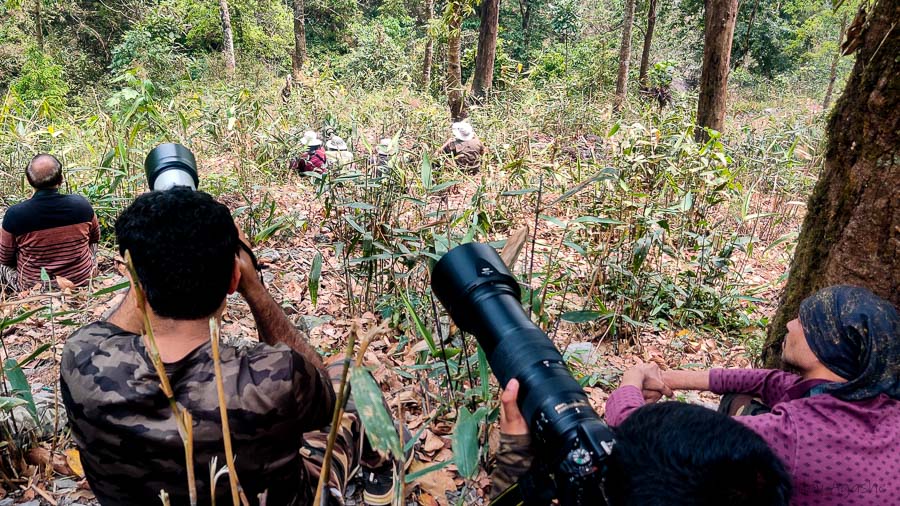
Eager Photographers
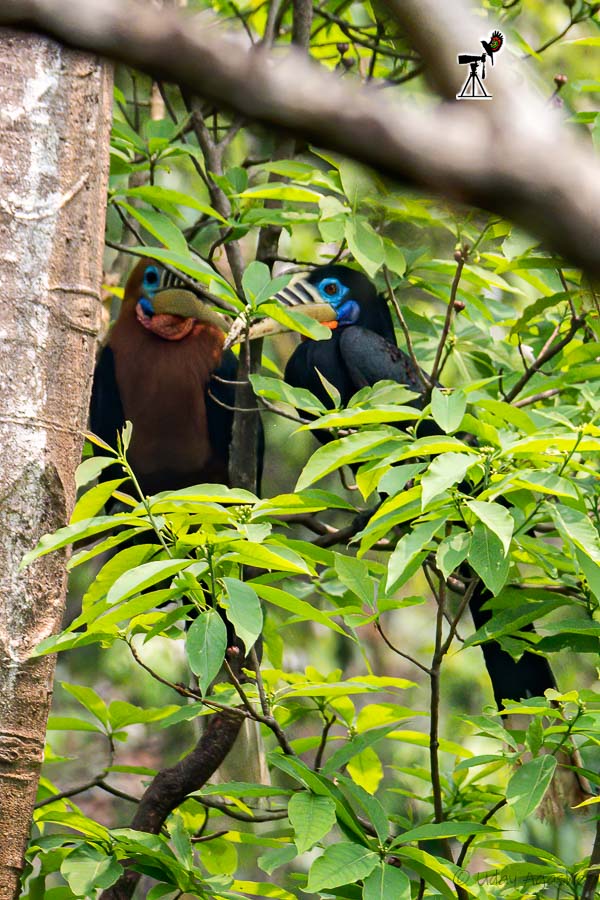
Rufous-necked Hornbills-Pair
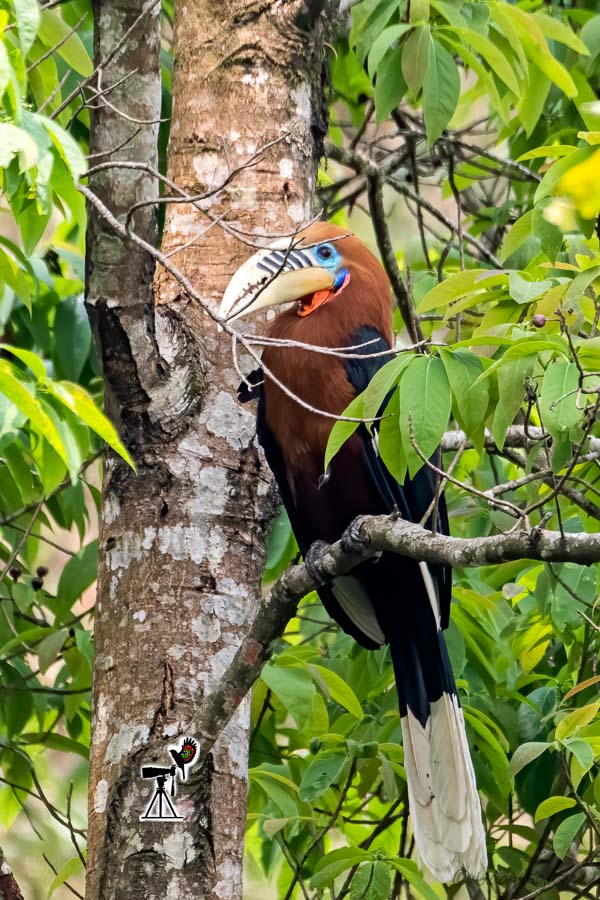
Rufous-necked Hornbill-Male
We got back into our vehicles and headed home. The rain had already started by the time we reached.
The rain looked really bad today. We had our lunch and then waited for the Sun to shine again. At about 3 o’clock, it looked little better and we decided to take a chance. We again went to the Nursery trail and this time heard the calls of Red-headed trogon, and soon we were even able to sight them far below in the valley. We even managed to get photos with super high ISO. Just a few photos and it appeared to be cloudy once again and we decided to return back from our last trail.
Tonight, we just packed our bags and were ready to leave early. But before that we had lots of discussions about the trip in general and specific birds seen/ not-seen and so on.
Overall, it was a very good birding experience, though photography point of view, it may not have been as good as expected. On the positive side, I was able to get some 50 lifers in that 6 day trip.
9th April - Day 8
Technically our last day of trip but it was only for travelling back and unfortunately we were going back into the world of COVID.. the world of masks, sanitizers, containment zone and …..
For the entire week otherwise, we were really in a good place, just enjoying the nature, the birds and thinking about what we would see next and nothing else!
We started at 5am as we had lot of distance to cover and with the COVID related measures reaching airport early made sense. Flight was on time and in Mumbai there was no traffic at that hour (3pm). We were home by 4pm, safe and sound but back into the worrying world.
Additional Info - Camera Gear
- Camera: Canon 80D (Crop-sensor body)
- Lens: Tamron 150-600 mm (version G2)
- Tripod: Most of the Photos are taken using Tripod (Sirui N3004 with K-30x Ball head)
- Exposure: Manual Exposure for all photos
- Focus Mode: AUTO – except for birds in clutter
Additional Info - List of birds seen (day wise)